New York City
For other uses, see New York City (disambiguation).
"NYC" and "New York, New York" redirect here. For other uses, see NYC (disambiguation) and New York, New York (disambiguation).
| New York City | |||
|---|---|---|---|
| City | |||
| City of New York | |||
| Clockwise from top: Midtown Manhattan, the United Nations Headquarters, the Statue of Liberty, the Brooklyn Bridge, Central Park, Times Square, and the Unisphere in Queens | |||
|
|||
| Nickname(s):
Main article: Nicknames of New York City
|
|||
| Location in New York State | |||
| Coordinates: 40°40.2′N 73°56.4′WCoordinates: 40°40.2′N 73°56.4′W[1] | |||
| Country | |||
| State | |||
| Counties | Bronx, Kings, New York, Queens, Richmond |
||
| Historic colony | |||
| Settled | 1624 | ||
| Incorporated | 1898 | ||
| Government[2] | |||
| • Type | Mayor–Council | ||
| • Body | New York City Council | ||
| • Mayor | Michael Bloomberg (I), term ends December 31, 2013; to be succeeded by Bill de Blasio (D) | ||
| Area[1] | |||
| • Total | 468.5 sq mi (1,213 km2) | ||
| • Land | 302.6 sq mi (784 km2) | ||
| • Water | 165.8 sq mi (429 km2) | ||
| • Metro | 13,318 sq mi (34,490 km2) | ||
| Elevation[3] | 33 ft (10 m) | ||
| Population [5] | |||
| • Estimate (2012) | 8,336,697[4] | ||
| • Rank | 1st, U.S. | ||
| • Density | 27,550/sq mi (10,640/km2) | ||
| • Metro | 19,831,858 (1st) | ||
| • CSA | 23,362,099 (1st) | ||
| Demonym | New Yorker | ||
| Time zone | Eastern (EST) (UTC-5) | ||
| • Summer (DST) | EDT (UTC-4) | ||
| ZIP code(s) | 100xx–104xx, 11004–05, 111xx–114xx, 116xx | ||
| Area code(s) | 212, 347, 646, 718, 917, 929 | ||
| FIPS code | 36-51000 | ||
| GNIS feature ID | 975772 | ||
| Website | www.nyc.gov | ||
Located on one of the world's largest natural harbors,[14] New York City consists of five boroughs, each of which is a county of New York State.[15] The five boroughs—The Bronx, Brooklyn, Manhattan, Queens, and Staten Island—were consolidated into a single city in 1898.[16][17] With a census-estimated 2012 population of 8,336,697[4] distributed over a land area of just 302.64 square miles (783.8 km2),[4] New York is the most densely populated major city in the United States.[18] As many as 800 languages are spoken in New York,[19] making it the most linguistically diverse city in the world.[20][21] By 2012 census estimates, the New York Metropolitan Area's population remains by a significant margin the United States' largest Metropolitan Statistical Area, with approximately 19.8 million people,[22] and is also part of the most populous Combined Statistical Area in the United States, containing an estimated 23.4 million people.[23]
New York traces its roots to its 1624 founding as a trading post by colonists of the Dutch Republic and was named New Amsterdam in 1626.[24] The city and its surroundings came under English control in 1664[24][25] and were renamed New York after King Charles II of England granted the lands to his brother, the Duke of York.[26][27] New York served as the capital of the United States from 1785 until 1790.[28] It has been the country's largest city since 1790.[29] The Statue of Liberty greeted millions of immigrants as they came to America by ship in the late 19th and early 20th centuries[30] and is a globally recognized symbol of the United States and its democracy.[31]
Many districts and landmarks in New York City have become well known to its approximately 50 million annual visitors.[32][33][34] Times Square, iconified as "The Crossroads of the World",[35][36][37][38][39] is the brightly illuminated hub of the Broadway theatre district,[40] one of the world's busiest pedestrian intersections,[41][42] and a major center of the world's entertainment industry.[43] The names of many of the city's bridges, skyscrapers,[44] and parks are known around the world. New York City's financial district, anchored by Wall Street in Lower Manhattan, has been called the world's leading financial center[45][46][47][48][49] and is home to the New York Stock Exchange, the world's largest stock exchange by total market capitalization of its listed companies.[50] Manhattan's real estate market is among the most expensive in the world.[51][52] Manhattan's Chinatown incorporates the highest concentration of Chinese people in the Western Hemisphere.[53][54][55][56] Providing continuous 24/7 service,[57] the New York City Subway is one of the most extensive rapid transit systems worldwide. Numerous colleges and universities are located in New York,[58] including Columbia University, New York University, and Rockefeller University, which have been ranked among the top 35 in the world.[59]
Contents
History
Main article: History of New York City
Early history
In the precolonial era, the area of present day New York City was inhabited by various bands of Algonquian tribes of Native Americans, including the Lenape, whose homeland, known as Lenapehoking, included Staten Island, the western portion of Long Island (including the area that would become Brooklyn and Queens), Manhattan, and the Lower Hudson Valley, including The Bronx.[60]The first documented visit by a European was in 1524 by Giovanni da Verrazzano, a Florentine explorer in the service of the French crown, who sailed his ship La Dauphine into New York Harbor. He claimed the area for France and named it "Nouvelle Angoulême" (New Angoulême).[61]
In 1609, English explorer Henry Hudson re-discovered the region when he sailed his ship the Halve Maen ("Half Moon" in Dutch) into New York Harbor while searching for the Northwest Passage to the Orient for his employer the Dutch East India Company. He proceeded to sail up what he named the North River, also called the Mauritis River, and now known as the Hudson River, to the site of the present-day New York State capital of Albany in the belief that it might represent an oceanic tributary. When the river narrowed and was no longer saline, he realized it wasn't a sea passage and sailed back downriver. He made a ten-day exploration of the area and claimed the region for his employer. In 1614 the area between Cape Cod and Delaware Bay would be claimed by the Netherlands and called Nieuw-Nederland (New Netherland).
The first recorded non-Native American inhabitant of what would eventually become New York City was Dominican trader Juan Rodriguez (transliterated to Dutch as Jan Rodrigues). Born in Santo Domingo of Portuguese and African descent, he arrived in Manhattan during the winter of 1613–1614, trapping for pelts and trading with the local population as a representative of the Dutch. Broadway, from 159th Street to 218th Street, is named Juan Rodriguez Way in his honor.[63][64]
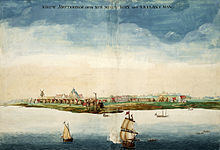
New Amsterdam, centered in the eventual Lower Manhattan, in 1664, the year England took control and renamed it "New York".
In 1664, Peter Stuyvesant, the Director-General of the colony of New Netherland, surrendered New Amsterdam to the English without bloodshed. The English promptly renamed the fledgling city "New York" after the Duke of York (later King James II).[72] At the end of the Second Anglo-Dutch War, the English gained New Amsterdam (New York) in North America in exchange for Dutch control of Run, an Indonesian island. Several intertribal wars among the Native Americans and some epidemics brought on by contact with the Europeans caused sizable population losses for the Lenape between the years 1660 and 1670.[73] By 1700, the Lenape population had diminished to 200.[74]
In 1702, the city lost 10% of its population to yellow fever.[75] New York suffered seven major yellow fever epidemics from 1702 to 1800.[76]
New York grew in importance as a trading port while under British rule in the early 1700s. It also became a center of slavery, with 42% of households holding slaves by 1730, more than any other city other than Charleston, South Carolina.[77] Most slaveholders held a few or several domestic slaves, but others hired them out to work at labor. Slavery became integrally tied to New York's economy through the labor of slaves throughout the port, and the banks and shipping tied to the South. Discovery of the African Burying Ground in the 1990s during construction of a new federal courthouse near Foley Square revealed that tens of thousands of Africans had been buried in the area in the colonial years.
The trial in Manhattan of John Peter Zenger in 1735 helped to establish the freedom of the press in North America. In 1754, Columbia University was founded under charter by King George II as King's College in Lower Manhattan.[78] The Stamp Act Congress met in New York in October 1765 as the Sons of Liberty organized in the city, skirmishing over the next ten years with British troops stationed there.

The Battle of Long Island, the largest battle of the American Revolution, took place in Brooklyn in 1776.
The only attempt at a peaceful solution to the war took place at the Conference House on Staten Island between American delegates including Benjamin Franklin, and British general Lord Howe on September 11, 1776. Shortly after the British occupation began the Great Fire of New York occurred, a large conflagration which destroyed about a quarter of the buildings in the city, including Trinity Church.[79]
In 1785, the assembly of the Congress of the Confederation made New York the national capital shortly after the war. New York was the last capital of the U.S. under the Articles of Confederation and the first capital under the Constitution of the United States. In 1789 the first President of the United States, George Washington, was inaugurated; the first United States Congress and the Supreme Court of the United States each assembled for the first time, and the United States Bill of Rights was drafted, all at Federal Hall on Wall Street.[80] By 1790, New York had surpassed Philadelphia as the largest city in the United States.
Under New York State's "Gradual Abolition law of 1799", children of slave mothers were born to be eventually liberated but were held in indentured servitude until their mid-to-late twenties.[82] Together with slaves freed by their masters after the Revolutionary War and escaped slaves, gradually a significant free-black population developed in Manhattan. Under such influential United States founders as Alexander Hamilton and John Jay the New York Manumission Society worked for abolition and established the African Free School to educate black children.[83] It was not until 1827 that slavery was completely abolished in the state, and free blacks struggled afterward with discrimination. New York interracial abolitionist activism continued; among its leaders were graduates of the African Free School. The city's black population reached more than 16,000 in 1840.[84]
In the 19th century, the city was transformed by development relating to its status as a trading center, as well as by European immigration.[85] The city adopted the Commissioners' Plan of 1811, which expanded the city street grid to encompass all of Manhattan. The 1819 opening of the Erie Canal through central New York connected the Atlantic port to the agricultural markets and commodities of the North American interior via the Hudson River and the Great Lakes.[86] Local politics became dominated by Tammany Hall, a political machine supported by Irish and German immigrants.[87]
Several prominent American literary figures lived in New York during the 1830s and 1840s, including William Cullen Bryant, Washington Irving, Herman Melville, Rufus Wilmot Griswold, John Keese, Nathaniel Parker Willis, and Edgar Allan Poe. Public-minded members of the old merchant elite lobbied for the establishment of Central Park, which in 1857 became the first landscaped park in an American city.
Modern history
Democratic Party candidates were consistently elected to local office, increasing the city's ties to the South and its dominant party. In 1861 Mayor Fernando Wood called on the aldermen to declare independence from Albany and the United States after the South seceded, but his proposal was not acted on.[83] Anger at new military conscription laws during the American Civil War (1861–1865) led to the Draft Riots of 1863, led by ethnic Irish working class.[83]
The situation deteriorated into attacks on black New Yorkers and their property, following fierce competition for a decade between immigrants and blacks for work. Rioters burned the Colored Orphan Asylum to the ground, but its more than 200 children escaped harm.[89] Rioters killed an estimated 100 blacks and attacked many more, especially in the docks area. It was one of the worst incidents of civil unrest in American history.[90] Because of the violence, many blacks left the city for Williamsburg, Brooklyn and New Jersey; the black population in Manhattan fell below 10,000 by 1865, which it had last been in 1820. The white working class had established dominance.[89]
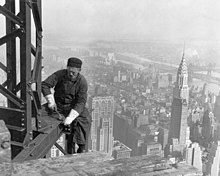
A construction worker on top of the Empire State Building as it was being built in 1930. The Chrysler Building is below and behind him.
In 1904, the steamship General Slocum caught fire in the East River, killing 1,021 people on board. In 1911, the Triangle Shirtwaist Factory fire, the city's worst industrial disaster, took the lives of 146 garment workers and spurred the growth of the International Ladies' Garment Workers' Union and major improvements in factory safety standards.[92]
New York's non-white population was 36,620 in 1890.[93] In the 1920s, New York City was a prime destination for African Americans during the Great Migration from the American South. By 1916, New York City was home to the largest urban African diaspora in North America. The Harlem Renaissance of literary and cultural life flourished during the era of Prohibition. The larger economic boom generated construction of competing skyscrapers that changed the skyline into its identifiable twentieth-century shape.
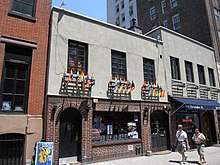
The Stonewall Inn in Greenwich Village, a designated National Historic Landmark as the site of the 1969 Stonewall Riots.[94]
Returning World War II veterans created a postwar economic boom and the development of large housing tracts in eastern Queens. New York emerged from the war unscathed as the leading city of the world, with Wall Street leading America's place as the world's dominant economic power. The United Nations Headquarters (completed in 1950) emphasized New York's political influence, and the rise of abstract expressionism in the city precipitated New York's displacement of Paris as the center of the art world.[97]
In the 1960s, job losses due to industrial restructuring caused New York City to suffer from economic problems and rising crime rates, which extended into the 1970s.[98] While a resurgence in the financial industry greatly improved the city's economic health in the 1980s, New York's crime rate continued to increase through the decade and into the beginning of the 1990s.[99] By the 1990s, crime rates started to drop dramatically due to revised police strategies, improving economic opportunities, gentrification, and new residents, both American transplants and new immigrants from Asia and Latin America. Important new sectors, such as Silicon Alley, emerged in the city's economy. New York's population reached all-time highs in the 2000 Census and then again in the 2010 Census.
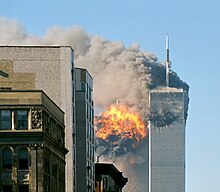
United Airlines Flight 175 hits the South Tower of the former World Trade Center on September 11, 2001.
Geography
Main articles: Geography of New York City and Geography of New York Harbor
The Hudson River flows through the Hudson Valley into New York Bay. Between New York City and Troy, New York, the river is an estuary.[108] The Hudson separates the city from New Jersey. The East River—a tidal strait—flows from Long Island Sound and separates the Bronx and Manhattan from Long Island. The Harlem River, another tidal strait between the East and Hudson Rivers, separates most of Manhattan from the Bronx. The Bronx River, which flows through the Bronx and Westchester County, is the only entirely fresh water river in the city.[109]
The city's land has been altered substantially by human intervention, with considerable land reclamation along the waterfronts since Dutch colonial times. Reclamation is most prominent in Lower Manhattan, with developments such as Battery Park City in the 1970s and 1980s.[110] Some of the natural relief in topography has been evened out, especially in Manhattan.[111]
The city's total area is 468.9 square miles (1,214 km2). 164.1 sq mi (425 km2) of this is water and 304.8 sq mi (789 km2) is land.[112][113] The highest point in the city is Todt Hill on Staten Island, which, at 409.8 feet (124.9 m) above sea level, is the highest point on the Eastern Seaboard south of Maine.[114] The summit of the ridge is mostly covered in woodlands as part of the Staten Island Greenbelt.[115]
Climate
Winters are cold and damp, and prevailing wind patterns that blow offshore minimize the moderating effects of the Atlantic Ocean; yet the Atlantic and the partial shielding of the Appalachians keep the city warmer in the winter than inland North American cities located at similar or lesser latitudes such as Pittsburgh, Cincinnati, and Indianapolis. The average daily high temperature in January, the area's coldest month, is 38.3 °F (3.5 °C); however, winter temperatures can occasionally reach as low as 0 °F (−18 °C),[121] and January temperatures have reached the low 70s (Fahrenheit). Spring and autumn are unpredictable and can range from chilly to warm, although they are usually mild with low humidity. Summers are typically warm to hot and humid, with an average daily July high temperature of 84.1 °F (28.9 °C). Nighttime conditions are often exacerbated by the urban heat island phenomenon, while daytime temperatures exceed 90 °F (32 °C) on average of 17 days each summer and can exceed 100 °F (38 °C).[122] Extreme temperatures have ranged from −15 °F (−26 °C), recorded on February 9, 1934, up to 106 °F (41 °C) on July 9, 1936.[123]
The city receives 49.7 inches (1,260 mm) of precipitation annually, which is fairly spread throughout the year. Average winter snowfall for 1981 to 2010 has been 26.7 inches (68 cm), but this usually varies considerably from year to year.[122] Hurricanes and tropical storms are rare in the New York area, but are not unheard of and always have the potential to strike the area.[124] Hurricane Sandy brought a destructive storm surge to New York City on the evening of October 29, 2012, flooding numerous streets, tunnels, and subway lines in Lower Manhattan and other areas of the city and cutting off electricity in many parts of the city and its suburbs.[125] The storm and its profound impacts have prompted the discussion of constructing seawalls and other coastal barriers around the shorelines of the city and the metropolitan area to minimize the risk of destructive consequences from another such event in the future.[126]
| [show]Climate data for New York (Belvedere Castle, Central Park) |
|---|
Demographics
Further information: Demographics of New York City, New York City ethnic enclaves, and Demographic profile of New York City
| [show]City compared to State & U.S. |
|---|
| Historical population | ||
|---|---|---|
| Year | Pop. | ±% |
| 1698 | 4,937 | — |
| 1712 | 5,840 | +18.3% |
| 1723 | 7,248 | +24.1% |
| 1737 | 10,664 | +47.1% |
| 1746 | 11,717 | +9.9% |
| 1756 | 13,046 | +11.3% |
| 1771 | 21,863 | +67.6% |
| 1790 | 49,401 | +126.0% |
| 1800 | 79,216 | +60.4% |
| 1810 | 119,734 | +51.1% |
| 1820 | 152,056 | +27.0% |
| 1830 | 242,278 | +59.3% |
| 1840 | 391,114 | +61.4% |
| 1850 | 696,115 | +78.0% |
| 1860 | 1,174,779 | +68.8% |
| 1870 | 1,478,103 | +25.8% |
| 1880 | 1,911,698 | +29.3% |
| 1890 | 2,507,414 | +31.2% |
| 1900 | 3,437,202 | +37.1% |
| 1910 | 4,766,883 | +38.7% |
| 1920 | 5,620,048 | +17.9% |
| 1930 | 6,930,446 | +23.3% |
| 1940 | 7,454,995 | +7.6% |
| 1950 | 7,891,957 | +5.9% |
| 1960 | 7,781,984 | −1.4% |
| 1970 | 7,894,862 | +1.5% |
| 1980 | 7,071,639 | −10.4% |
| 1990 | 7,322,564 | +3.5% |
| 2000 | 8,008,288 | +9.4% |
| 2010 | 8,175,133 | +2.1% |
| 2012 | 8,336,697 | +2.0% |
| Note:
Census figures (1790–2010) cover the present area of all five boroughs,
before and after the 1898 consolidation. For New York City itself
before annexing part of the Bronx in 1874, see Manhattan#Demographics.[130] Sources: 1698–1771,[131]
1790–1890,[130][132] 1900–1990,[133] 2000 and 2010 Census.[134][135] 2012 Census estimates.[4] |
||
Mayor Michael Bloomberg immediately challenged the Census Bureau's 2010 population count of 8,175,133 as representing an undercount upon release.[142] This amounts to about 40% of the state of New York's population and a similar percentage of the metropolitan regional population. In 2006, demographers estimated that New York's population will reach between 9.2 and 9.5 million by 2030.[143] The city's population in 2010 was 44% white (33.3% non-Hispanic white), 25.5% black (23% non-Hispanic black), 0.7% Native American and 12.7% Asian.[4]
Hispanics of any race represented 28.6% of the population,[4] while Asians constituted the fastest-growing segment of the city's population between 2000 and 2010; the non-Hispanic white population declined 3 percent, the smallest recorded decline in decades; and for the first time since the Civil War, the number of blacks declined over a decade.[142] In 2010, the city had a population density of 27,532 people per square mile (10,630/km²), rendering it the most densely populated of all municipalities housing over 100,000 residents in the United States; however, several small cities (of less than 100,000) in adjacent Hudson County, New Jersey are more dense overall, as per the 2000 Census.[144]
Geographically co-extensive with New York County, the borough of Manhattan's population density of 66,940 people per square mile[145] (25,846/km²) makes it the highest of any county in the United States[146] and higher than the density of any individual American city.[147]

Chinatown, Manhattan (紐約華埠). New York City is home to the largest population of overseas Chinese outside of Asia.[148]
Approximately 37% of the city's population is foreign born.[152][153] In New York, no single country or region of origin dominates.[152] The twelve largest sources of foreign-born individuals in the metropolitan area are the Dominican Republic, China, Jamaica, Mexico, India, Ecuador, Italy, Haiti, Colombia, Guyana, Russia and El Salvador.[154] The New York region continues to be by far the leading metropolitan gateway for legal immigrants admitted into the United States, substantially exceeding the combined totals of Los Angeles and Miami, the next most popular gateway regions.[155][156][157][158]
The New York City metropolitan area is ethnically diverse.[159] It is home to the largest Jewish community outside Israel.[160] The metropolitan area is also home to 20% of the nation's Indian Americans and at least 20 Little India enclaves, as well as 15% of all Korean Americans and four Koreatowns;[161][162] the largest Asian Indian population in the Western Hemisphere; the largest Russian American,[163] Italian American, and African American populations; the largest South American[163] and second-largest overall Hispanic communities in the United States; and includes 6 Chinatowns in New York City alone[164] with the urban agglomeration comprising as of the 2010 Census a population of 682,265 overseas Chinese,[161] the largest outside of Asia.[148] Multiple satellites of the original Manhattan Chinatown (紐約華埠), in Brooklyn (布鲁克林華埠), and around Flushing, Queens (法拉盛華埠), are thriving as traditionally urban enclaves, as large-scale Chinese immigration continues into New York and neighboring areas.[163][165][166][167]
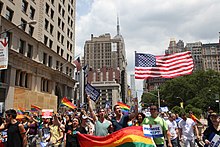
Greenwich Village. New York City is home to the largest gay and bisexual community in the United States.
Substantial Dominican[171] and Puerto Rican populations reside in the New York City metropolitan region. The Irish also have a notable presence; one in 50 New Yorkers of European origin carries a distinctive genetic signature on his Y chromosome inherited from the clan of Niall of the Nine Hostages, an Irish king of the fifth century A.D.[172] or from one of the related clans of Uí Briúin and Uí Fiachrach.[173]
The New York metropolitan area is home to a self-identifying gay and bisexual community estimated at 568,903 individuals, the largest in the United States.[174] Same-sex marriages in New York were legalized on June 24, 2011 and were authorized to take place beginning 30 days thereafter.[175]
New York City has a high degree of income disparity. In 2005, the median household income in the wealthiest census tract was $188,697, while in the poorest it was $9,320.[176] The disparity is driven by wage growth in high income brackets, while wages have stagnated for middle and lower income brackets. In the first quarter of 2013, the average weekly wage in New York County was $2,448, representing the highest total among the largest counties in the United States.[177] New York City is home to the highest number of the world's billionaires, higher than the next five U.S. cities combined,[178][179][180] including Mayor Michael R. Bloomberg.[181] Manhattan also experienced a baby boom between 2000 and 2007, during which period the number of children under age 5 living in the borough grew by more than 32%.[182]
Cityscape
Architecture
Further information: Architecture of New York City and List of tallest buildings in New York City
Manhattan's skyline with its many skyscrapers is universally recognized, and the city has been home to several of the tallest buildings in the world. As of 2011, New York City had 5,937 high-rise buildings, of which 550 completed structures were at least 100 meters high, both second in the world after Hong Kong,[184][185] with over 50 completed skyscrapers taller than 656 feet (200 m). These include the Woolworth Building (1913), an early gothic revival skyscraper built with massively scaled gothic detailing.
The 1916 Zoning Resolution required setbacks in new buildings, and restricted towers to a percentage of the lot size, to allow sunlight to reach the streets below.[186] The Art Deco style of the Chrysler Building (1930) and Empire State Building (1931), with their tapered tops and steel spires, reflected the zoning requirements. The buildings have distinctive ornamentation, such as the eagles at the corners of the 61st floor on the Chrysler Building, and are considered some of the finest examples of the Art Deco style.[187] A highly influential example of the international style in the United States is the Seagram Building (1957), distinctive for its façade using visible bronze-toned I-beams to evoke the building's structure. The Condé Nast Building (2000) is a prominent example of green design in American skyscrapers.[188]
The character of New York's large residential districts is often defined by the elegant brownstone rowhouses, townhouses, and shabby tenements that were built during a period of rapid expansion from 1870 to 1930.[189] In contrast, New York City also has neighborhoods that are less densely populated and feature free-standing dwellings. In neighborhoods such as Riverdale, Bronx; Ditmas Park, Brooklyn; and Douglaston, Queens, large single-family homes are common in various architectural styles such as Tudor Revival and Victorian.[190][191][192]
Stone and brick became the city's building materials of choice after the construction of wood-frame houses was limited in the aftermath of the Great Fire of 1835.[193] A distinctive feature of many of the city's buildings is the wooden roof-mounted water towers. In the 1800s, the city required their installation on buildings higher than six stories to prevent the need for excessively high water pressures at lower elevations, which could break municipal water pipes.[194] Garden apartments became popular during the 1920s in outlying areas, such as Jackson Heights.[195]
Parks
The City of New York has a complex park system, with various lands operated by the National Park Service, the New York State Office of Parks, Recreation and Historic Preservation, and the New York City Department of Parks and Recreation.In its 2013 ParkScore ranking, The Trust for Public Land reported that New York City had the 2nd best park system among the 50 most populous U.S. cities.[196] ParkScore ranks urban park systems by a formula that analyzes median park size, park acres as percent of city area, the percent of city residents within a half-mile of a park, spending of park services per resident, and the number of playgrounds per 10,000 residents.
National Park System units within city limits
Main article: National Park Service

New York Harbor's Statue of Liberty National Monument, in May 2001, with the former Twin Towers of the World Trade Center and Lower Manhattan in the background.
The Statue of Liberty National Monument and Ellis Island Immigration Museum are managed by the National Park Service and are located in both the states of New York and New Jersey. They are joined in the harbor by Governors Island National Monument, located in New York. Historic sites under federal management on Manhattan Island include Castle Clinton National Monument; Federal Hall National Memorial; Theodore Roosevelt Birthplace National Historic Site; General Grant National Memorial ("Grant's Tomb"); African Burial Ground National Monument; and Hamilton Grange National Memorial. Hundreds of private properties are listed on the National Register of Historic Places or as a National Historic Landmark such as, for example, the Stonewall Inn in Greenwich Village as the catalyst of the modern gay rights movement.[198][199]
New York State Parks
Main article: New York State Parks
There are seven state parks within the confines of New York City, including Clay Pit Ponds State Park Preserve, a natural area which includes extensive riding trails, and Riverbank State Park, a 28-acre (110,000 m2) facility that rises 69 feet (21 m) over the Hudson River.[200]New York City Department of Parks and Recreation
See also: Parks and recreation in New York City
New York City has over 28,000 acres (110 km2) of municipal parkland and 14 miles (23 km) of public beaches.[202] Parks in New York City include Central Park, Prospect Park, Flushing Meadows–Corona Park, Forest Park, and Washington Square Park. The largest municipal park in the city is Pelham Bay Park with 2,700 acres (1,093 ha).[203]- Central Park an 883-acre (3.57 km2) park in Manhattan, is the most visited city park in the United States, with 25 million visitors each year.[204] The park contains a myriad of attractions; there are several lakes and ponds, two ice-skating rinks, the Central Park Zoo, the Central Park Conservatory Garden, the 106-acre (0.43 km2) Jackie Onassis Reservoir. Indoor attractions include Belvedere Castle with its nature center, the Swedish Cottage Marionette Theater, and the historic Carousel. On October 23, 2012, hedge fund manager John A. Paulson announced a $100 million gift to the Central Park Conservancy, the largest ever monetary donation to New York City's park system.[205]
- Prospect Park in Brooklyn has a 90-acre (360,000 m2) meadow, a lake and extensive woodlands. Located within the park is the historic Battle Pass, which figured prominently in the Battle of Long Island.[206]
- Flushing Meadows–Corona Park in Queens, the city's third largest park, was the setting for the 1939 World's Fair and the 1964 World's Fair.[207]
- Over a fifth of the Bronx's area, 7,000 acres (28 km2), is given over to open space and parks, including Van Cortlandt Park, Pelham Bay Park, the Bronx Zoo, and the New York Botanical Gardens.[208]
- In Staten Island, the Conference House Park contains the historic Conference House, site of the only attempt of a peaceful resolution to the American Revolution, attended by Benjamin Franklin representing the Americans and Lord Howe representing the British Crown. Located within the park is the historic Burial Ridge, the largest Native American burial ground within New York City.
Boroughs
Further information: Borough (New York City) and Neighborhoods in New York City

The Five Boroughs of New York City: 1: Manhattan 2: Brooklyn 3: Queens 4: The Bronx 5: Staten Island
|
|
|||||||||||||||||||||||||||||||||||||||||||||||||||||||
Throughout the boroughs there are hundreds of distinct neighborhoods, many with a definable history and character to call their own. If the boroughs were each independent cities, four of the boroughs (Brooklyn, Queens, Manhattan, and The Bronx) would be among the ten most populous cities in the United States.
- Manhattan (New York County) is the most densely populated borough and is home to Central Park and most of the city's skyscrapers. Most of the borough is on Manhattan Island, at the mouth of the Hudson River. Manhattan is the financial center of the city and contains the headquarters of many major corporations, the UN, a number of important universities, and many cultural attractions. Manhattan is loosely divided into Lower, Midtown, and Uptown regions. Uptown Manhattan is divided by Central Park into the Upper East Side and the Upper West Side, and above the park is Harlem. New York City's remaining four boroughs are collectively referred to as the "outer boroughs".
- The Bronx (Bronx County) is New York City's northernmost borough, the location of Yankee Stadium, home of the New York Yankees, and home to the largest cooperatively owned housing complex in the United States, Co-op City.[212] Except for a small section of Manhattan known as Marble Hill, the Bronx is the only section of the city that is part of the United States' mainland. It is home to the Bronx Zoo, the world's largest metropolitan zoo,[201] which spans 265 acres (1.07 km2) and is home to over 6,000 animals.[213] The Bronx is the birthplace of rap and hip hop culture.[214]
- Brooklyn (Kings County) on the western tip of Long Island, is the city's most populous borough and was an independent city until 1898. Brooklyn is known for its cultural, social and ethnic diversity, an independent art scene, distinct neighborhoods and a distinctive architectural heritage. Downtown Brooklyn is the only central core neighborhood in the outer boroughs. The borough features a long beachfront shoreline including Coney Island, established in the 1870s as one of the earliest amusement grounds in the country.[215]
- Queens (Queens County) on Long Island east of Brooklyn, is geographically the largest borough and the most ethnically diverse county in the United States.[216] Historically a collection of small towns and villages founded by the Dutch, the borough has since developed both commercial and residential prominence. Queens County is the only large county in the United States where the median income among African Americans, approximately $52,000 a year, is higher than that of White Americans.[217] Queens is the site of Citi Field, the home of the New York Mets, and annually hosts the U.S. Open tennis tournament. Additionally, it is home to two of the three major airports serving the New York metropolitan area, LaGuardia Airport and John F. Kennedy International Airport. (The third is Newark Liberty International Airport in Newark, New Jersey.)
- Staten Island (Richmond County) is the most suburban in character of the five boroughs. Staten Island is connected to Brooklyn by the Verrazano-Narrows Bridge and to Manhattan by way of the free Staten Island Ferry. The Staten Island Ferry is one of the most popular tourist attractions in New York City as it provides unsurpassed views of the Statue of Liberty, Ellis Island, and lower Manhattan. Located in central Staten Island, the 2,500 acres (10.1 km2) Staten Island Greenbelt has some 28 miles (45 km) of walking trails and one of the last undisturbed forests in the city.[218] Designated in 1984 to protect the island's natural lands, the Greenbelt comprises seven city parks.
Culture and contemporary life
Further information: Culture of New York City and List of people from New York City
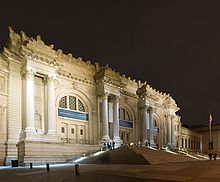
The Metropolitan Museum of Art, part of Museum Mile in the Carnegie Hill neighborhood of Manhattan's Upper East Side, is one of the largest museums in the world.[219]
Numerous major American cultural movements began in the city, such as the Harlem Renaissance, which established the African-American literary canon in the United States.[223][224] The city was a center of jazz[225] in the 1940s, abstract expressionism in the 1950s and the birthplace of hip hop in the 1970s.[226] The city's punk[227] and hardcore[228] scenes were influential in the 1970s and 1980s, and the city has long had a flourishing scene for Jewish American literature.
The city is the birthplace of many cultural movements, including the Harlem Renaissance in literature and visual art; abstract expressionism (also known as the New York School) in painting; and hip hop,[214] punk, salsa, disco, freestyle, Tin Pan Alley and Jazz in music. New York City has been considered the dance capital of the world.[229][230][231] The city is also widely celebrated in popular lore, featured frequently as the setting for books, movies (see New York in film), television programs, etc.
Entertainment and performing arts
See also: Music of New York City
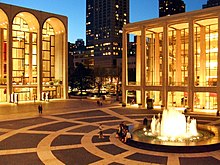
The Lincoln Center for the Performing Arts is home of the New York Philharmonic and other performing arts.
The city government funds the arts with a larger annual budget than the National Endowment for the Arts.[235] Wealthy industrialists in the 19th century built a network of major cultural institutions, such as the famed Carnegie Hall and The Metropolitan Museum of Art, that would become internationally established. The advent of electric lighting led to elaborate theater productions, and in the 1880s New York City theaters on Broadway and along 42nd Street began featuring a new stage form that became known as the Broadway musical. Strongly influenced by the city's immigrants, productions such as those of Harrigan and Hart, George M. Cohan, and others used song in narratives that often reflected themes of hope and ambition.
Forty of the city's theaters, with more than 500 seats each, are collectively known as "Broadway," after the major thoroughfare that crosses the Times Square Theater District,[236] sometimes referred to as "The Great White Way".[237][238][239] Lincoln Center for the Performing Arts is home to 12 influential arts organizations, including the Metropolitan Opera, New York City Opera, New York Philharmonic, and New York City Ballet, as well as the Vivian Beaumont Theater, the Juilliard School, Jazz at Lincoln Center, and Alice Tully Hall. The Lee Strasberg Theatre and Film Institute is located in Union Square, and Tisch School of the Arts is based at New York University, while Central Park SummerStage presents performances of free plays and music in Central Park.[240]
Tourism
Further information: Tourism in New York City and List of museums and cultural institutions in New York City
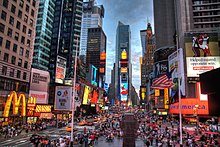
Times Square has the highest annual attendance rate of any tourist attraction in the US,[241] and according to Travel + Leisure magazine's October 2011 survey, the world.[41]
Major destinations include the Empire State Building; Statue of Liberty; Ellis Island; Broadway theater productions; museums such as the Metropolitan Museum of Art; greenspaces such as Central Park and Washington Square Park; Rockefeller Center; Times Square; the Manhattan Chinatown; luxury shopping along Fifth and Madison Avenues; and events such as the Halloween Parade in Greenwich Village; the Macy's Thanksgiving Day Parade; the lighting of the Rockefeller Center Christmas Tree; the St. Patrick's Day parade; seasonal activities such as ice skating in Central Park in the wintertime; the Tribeca Film Festival; and free performances in Central Park at Summerstage. Special experiences outside the key tourist areas of the city include the Bronx Zoo; Coney Island; Flushing Meadows-Corona Park; and the New York Botanical Garden. Plans were unveiled by Mayor Michael Bloomberg on September 27, 2012 for the New York Wheel, the world's tallest ferris wheel, to be built at the northern shore of Staten Island, overlooking the Statue of Liberty, New York Harbor, and the Lower Manhattan skyline.[243][244]
In 2010, New York City received nearly 49 million tourists,[245][246] subsequently surpassed by a record 50 million tourists in 2011.[247][248]
Media
Main article: Media in New York City
More than 200 newspapers and 350 consumer magazines have an office in the city[251] and the book-publishing industry employs about 25,000 people.[252] Two of the three national daily newspapers in the United States are New York papers: The Wall Street Journal and The New York Times, which has won the most Pulitzer Prizes for journalism. Major tabloid newspapers in the city include: The New York Daily News, which was founded in 1919 by Joseph Medill Patterson[253] and The New York Post, founded in 1801 by Alexander Hamilton.[254] The city also has a comprehensive ethnic press, with 270 newspapers and magazines published in more than 40 languages.[255] El Diario La Prensa is New York's largest Spanish-language daily and the oldest in the nation.[256] The New York Amsterdam News, published in Harlem, is a prominent African American newspaper. The Village Voice is the largest alternative newspaper.
The television industry developed in New York and is a significant employer in the city's economy. The four major American broadcast networks are all headquartered in New York: ABC, CBS, Fox, and NBC. Many cable channels are based in the city as well, including MTV, Fox News, HBO, and Comedy Central. In 2005, there were more than 100 television shows taped in New York City.[257] The City of New York operates a public broadcast service, NYCTV,[258] that has produced several original Emmy Award-winning shows covering music and culture in city neighborhoods and city government.
New York is also a major center for non-commercial educational media. The oldest public-access television channel in the United States is the Manhattan Neighborhood Network, founded in 1971.[259] WNET is the city's major public television station and a primary source of national Public Broadcasting Service (PBS) television programming. WNYC, a public radio station owned by the city until 1997, has the largest public radio audience in the United States.[260]
Cuisine
Main article: Cuisine of New York City
Accent
The New York area has a distinctive regional speech pattern called the New York dialect, alternatively known as Brooklynese or New Yorkese. It is generally considered one of the most recognizable accents within American English.[264] The classic version of this dialect is centered on middle and working-class people of European descent, and the influx of non-European immigrants in recent decades has led to changes in this distinctive dialect.[265]The traditional New York area accent is non-rhotic, so that the sound [ɹ] does not appear at the end of a syllable or immediately before a consonant; hence the pronunciation of the city name as "New Yawk."[265] There is no [ɹ] in words like park [pɑək] or [pɒək] (with vowel backed and diphthongized due to the low-back chain shift), butter [bʌɾə], or here [hiə]. In another feature called the low back chain shift, the [ɔ] vowel sound of words like talk, law, cross, chocolate, and coffee and the often homophonous [ɔr] in core and more are tensed and usually raised more than in General American.
In the most old-fashioned and extreme versions of the New York dialect, the vowel sounds of words like "girl" and of words like "oil" become a diphthong [ɜɪ]. This is often misperceived by speakers of other accents as a reversal of the er and oy sounds, so that girl is pronounced "goil" and oil is pronounced "erl"; this leads to the caricature of New Yorkers saying things like "Joizey" (Jersey), "Toidy-Toid Street" (33rd St.) and "terlet" (toilet).[265] The character Archie Bunker from the 1970s sitcom All in the Family (played by Carroll O'Connor) was a good example of a speaker with this feature. This speech pattern is no longer prevalent.[265]
Sports
Main article: Sports in New York City
The New York Marathon is the largest marathon in the world.[266]
The US Open Tennis Championships are held every August and September in Flushing Meadows-Corona Park, Queens.
Citi Field, also located in Flushing Meadows-Corona Park, has been home to the New York Mets since 2009.
New York has been described as the "Capital of Baseball".[273] There have been 35 Major League Baseball World Series and 73 pennants won by New York teams. It is one of only five metro areas (Los Angeles, Chicago, Baltimore–Washington, and the San Francisco Bay Area being the others) to have two baseball teams. Additionally, there have been 14 World Series in which two New York City teams played each other, known as a Subway Series and occurring most recently in 2000. No other metropolitan area has had this happen more than once (Chicago in 1906, St. Louis in 1944, and the San Francisco Bay Area in 1989).
The city's two current Major League Baseball teams are the New York Mets[274] and the New York Yankees,[275] who compete in six games of interleague play every regular season that has also come to be called the Subway Series. The Yankees have won a record 27 championships,[276] while the Mets have won the World Series twice.[277] The city also was once home to the Brooklyn Dodgers (now the Los Angeles Dodgers), who won the World Series once,[278] and the New York Giants (now the San Francisco Giants), who won the World Series five times. Both teams moved to California in 1958.[279] There are also two Minor League Baseball teams in the city, the Brooklyn Cyclones[280] and Staten Island Yankees.[281]
The city is represented in the National Football League by the New York Giants and the New York Jets, although both teams play their home games at MetLife Stadium in nearby East Rutherford, New Jersey,[282] which will host Super Bowl XLVIII in 2014.[283]
The New York Rangers represent the city in the National Hockey League.[284] The New York Islanders, who currently play in Nassau County, New York on Long Island,[285] will become the second team in the city after their move to Brooklyn in 2015.[286] Also within the metropolitan area are the New Jersey Devils, who play in nearby Newark, New Jersey.[287]
The city's National Basketball Association teams include the Brooklyn Nets and the New York Knicks, while the city's Women's National Basketball Association team is the New York Liberty. The first national college-level basketball championship, the National Invitation Tournament, was held in New York in 1938 and remains in the city.[288]
In soccer, New York is represented by the Major League Soccer side, New York Red Bulls. The Red Bulls play their home games at Red Bull Arena in nearby Harrison, New Jersey.[289] The New York area's second Major League Soccer club, to be called New York City FC, is planned to start play in the 2015 season, to be majority-owned by Manchester City F.C. owner Sheikh Mansour bin Zayed bin Sultan Al Nahyan of Abu Dhabi, partnering with the New York Yankees baseball organization.[290]
Queens is host of the U.S. Open Tennis Championships, one of the four annual Grand Slam tournaments.[291] The New York Marathon is one of the world's largest, and the 2004–2006 events hold the top three places in the marathons with the largest number of finishers, including 37,866 finishers in 2006.[266] The Millrose Games is an annual track and field meet whose featured event is the Wanamaker Mile. Boxing is also a prominent part of the city's sporting scene, with events like the Amateur Boxing Golden Gloves being held at Madison Square Garden each year.[292]
Many sports are associated with New York's immigrant communities. Stickball, a street version of baseball, was popularized by youths in the 1930s. A street in the Bronx has been renamed Stickball Blvd, as tribute to New York's most known street sport.[293]
Economy
Main article: Economy of New York City
| Top publicly traded companies in New York City for 2012 (ranked by revenues) with City and U.S. ranks |
|||||
| NYC | corporation | US | |||
| 1 | Verizon Communications | 16 | |||
| 2 | J.P. Morgan Chase & Co. | 18 | |||
| 3 | Citigroup | 26 | |||
| 4 | American International Group | 38 | |||
| 5 | INTL FCStone | 39 | |||
| 6 | MetLife | 40 | |||
| 7 | Pfizer | 48 | |||
| 8 | Goldman Sachs Group | 68 | |||
| 9 | Hess | 75 | |||
| 10 | New York Life Insurance | 89 | |||
| 11 | American Express | 90 | |||
| 12 | News Corporation | 91 | |||
| Financial services firms in green | |||||
| Full table at Economy of New York City | |||||
| Source: Fortune 500[294] | |||||
The New York metropolitan area had a gross metropolitan product (GMP) of approximately $1.28 trillion in 2010,[297] making it the largest regional economy in the United States. According to Cinco Dias, New York controlled 40% of the world's finances by the end of 2008, making it the largest financial center in the world.[298][299][300]
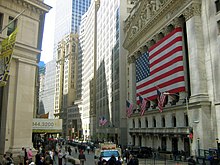
The New York Stock Exchange on Wall Street, the world's largest stock exchange per total market capitalization of its listed companies.[301]
Many major corporations are headquartered in New York City, including 45 Fortune 500 companies.[304] New York is also unique among American cities for its large number of foreign corporations. One out of ten private sector jobs in the city is with a foreign company.[305] This ability to attract foreign investment helped New York City top the FDi Magazine American Cities of the Future ranking for 2013.[306]
Real estate is a major force in the city's economy, as the total value of all New York City property was $802.4 billion in 2006.[307] The Time Warner Center is the property with the highest-listed market value in the city, at $1.1 billion in 2006.[307] New York City is home to some of the nation's—and the world's—most valuable real estate. 450 Park Avenue was sold on July 2, 2007 for $510 million, about $1,589 per square foot ($17,104/m²), breaking the barely month-old record for an American office building of $1,476 per square foot ($15,887/m²) set in the June 2007 sale of 660 Madison Avenue.[308]
The city's television and film industry is the second largest in the country after Hollywood.[309] Creative industries such as new media, advertising, fashion, design and architecture account for a growing share of employment, with New York City possessing a strong competitive advantage in these industries.[310]
High-tech industries like biotechnology, software development, game design, and internet services are also growing, bolstered by the city's position at the terminus of several transatlantic fiber optic trunk lines.[311] Other important sectors include medical research and technology, non-profit institutions, and universities. Manufacturing accounts for a large but declining share of employment. Garments, chemicals, metal products, processed foods, and furniture are some of the principal products.[312] The food-processing industry is the most stable major manufacturing sector in the city.[313] Food making is a $5 billion industry that employs more than 19,000 residents. Chocolate is New York City's leading specialty-food export, with $234 million worth of exports each year.[313]
Wall Street
Main article: Wall Street
Manhattan had approximately 520 million square feet (48.1 million m²) of office space in 2013,[314] making it the largest office market in the United States,[315] while Midtown Manhattan is the largest central business district in the nation.[316]Lower Manhattan is the third largest central business district in the United States and is home to the New York Stock Exchange, located on Wall Street, and the NASDAQ, representing the world's largest and second largest stock exchanges, respectively, when measured by average daily trading volume and overall market capitalization.[317] Financial services account for more than 35% of the city's employment income.[318] Wall Street investment banking fees in 2012 totaled approximately $40 billion.[319]
The financial district has sometimes been a scene of conflict such as with the recurrent protests during "Occupy Wall Street", which subsequently sparked an international Occupy Movement. It has also sometimes turned deadly such as with the Wall Street bombing in 1929.
In July 2013, NYSE Euronext, the operator of the New York Stock Exchange, took over the administration of the London interbank offered rate from the British Bankers Association.[320]
Law and government
| Year | Democratic | Republican | |||
|---|---|---|---|---|---|
| 2012 | 81.19% | 1,995,241 | 17.78% | 436,889 | |
| 2008 | 79.29% | 2,074,159 | 20.06% | 524,787 | |
| 2004 | 74.99% | 1,828,015 | 24.10% | 587,534 | |
| 2000 | 77.90% | 1,703,364 | 18.23% | 398,726 | |
| 1996 | 77.10% | 1,512,248 | 17.31% | 339,537 | |
| 1992 | 68.72% | 1,458,784 | 24.00% | 509,423 | |
| 1988 | 66.17% | 1,340,795 | 32.84% | 665,407 | |
| 1984 | 60.96% | 1,343,875 | 38.66% | 852,317 | |
| 1980 | 54.88% | 1,052,178 | 37.51% | 719,278 | |
| 1976 | 66.37% | 1,423,380 | 32.95% | 706,663 | |
| 1972 | 51.46% | 1,342,996 | 48.27% | 1,259,873 | |
| 1968 | 60.56% | 1,582,681 | 33.94% | 886,959 | |
| 1964 | 73.02% | 2,183,646 | 26.81% | 801,877 | |
| 1960 | 62.62% | 1,936,323 | 37.04% | 1,145,205 | |
Main article: Government of New York City

New York City Hall is the oldest City Hall in the United States that still houses its original governmental functions.
The Democratic Party holds the majority of public offices. As of November 2008, 67% of registered voters in the city are Democrats.[327] New York City has not been carried by a Republican in a statewide or presidential election since 1924. Party platforms center on affordable housing, education and economic development, and labor politics are of importance in the city.
Following a financial crisis and state bailout in 1975, the New York Financial Control Board was created to oversee municipal spending. The Mayor of New York City and the Governor of New York both serve on the seven-member board.[328] While direct management of the city's budget ended in 1986, the board continues to monitor the city's financial health.[329]
New York is the most important source of political fundraising in the United States, as four of the top five ZIP codes in the nation for political contributions are in Manhattan. The top zip code, 10021 on the Upper East Side, generated the most money for the 2004 presidential campaigns of George W. Bush and John Kerry.[330] The city has a strong imbalance of payments with the national and state governments. It receives 83 cents in services for every $1 it sends to the federal government in taxes (or annually sends $11.4 billion more than it receives back). The city also sends an additional $11 billion more each year to the state of New York than it receives back.[331]
Each borough is coextensive with a judicial district of the New York Supreme Court and hosts other state and city courts. Manhattan also hosts the Supreme Court Appellate Division, First Department, while Brooklyn hosts the Appellate Division, Second Department. Federal courts located near City Hall include the United States District Court for the Southern District of New York, the United States Court of Appeals for the Second Circuit, and the Court of International Trade. Brooklyn hosts the United States District Court for the Eastern District of New York.
Environmental issues
Further information: Environmental issues in New York City and Food and water in New York City
Mass transit use in New York City is the highest in the United
States, and gasoline consumption in the city is the same rate as the
national average in the 1920s.[332] The city's high level of mass transit use saved 1.8 billion US gallons (6,800,000 m3) of oil in 2006; New York City saves half of all the oil saved by transit nationwide.[333]
The city's population density, low automobile use and high transit
utility make it among the most energy efficient cities in the United
States.[334] Its greenhouse gas emissions are 7.1 metric tons per person compared with the national average of 24.5.[335] New Yorkers are collectively responsible for 1% of the nation's greenhouse gas emissions[335]
though they comprise 2.7% of the nation's population. The average New
Yorker consumes less than half the electricity used by a resident of San
Francisco and nearly one-quarter the electricity consumed by a resident
of Dallas.[336]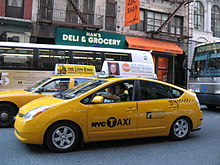
As of July 2010 the city had 3,715 hybrid taxis in service, the largest number in any city in North America.
The city government was a petitioner in the landmark Massachusetts v. Environmental Protection Agency Supreme Court case forcing the EPA to regulate greenhouse gases as pollutants. The city is also a leader in the construction of energy-efficient green office buildings, including the Hearst Tower among others.[188]
The city is supplied with drinking water by the protected Catskill Mountains watershed.[341] As a result of the watershed's integrity and undisturbed natural water filtration system, New York is one of only four major cities in the United States with drinking water pure enough not to require purification by water treatment plants.[342]
New York is the only US city in which a majority (52%) of households do not have a car; only 22% of Manhattanites own a car.[343]
Crime
Further information: Crime in New York City and Law enforcement in New York City
In 2012, New York City had the lowest overall crime rate and the second lowest murder rate among the largest U.S. cities,[344] having become significantly safer after a spike in crime in the 1980s[345] and early 1990s from the crack epidemic that affected many neighborhoods. By 2002, New York City had about the same crime rate as Provo, Utah
and was ranked 197th in crime among the 216 U.S. cities with
populations greater than 100,000. Violent crime in New York City
decreased more than 75% from 1993 to 2005 and continued decreasing
during periods when the nation as a whole saw increases.[346] In 2005 the homicide rate was at its lowest level since 1966,[347] and in 2007 the city recorded fewer than 500 homicides for the first time ever since crime statistics were first published in 1963.[348]
95.1% of all murder victims and 95.9% of all shooting victims in New
York City are black or Hispanic. And 90.2 percent of those arrested for
murder and 96.7 percent of those arrested for shooting someone are black
or Hispanic.[349] New York experienced a record low homicide rate in 2012 and has a far lower murder rate than other major American cities.[350]Sociologists and criminologists have not reached consensus on what explains the dramatic decrease in the city's crime rate. Some attribute the phenomenon to new tactics used by the New York City Police Department,[351] including its use of CompStat and the broken windows theory.[352] Others cite the end of the crack epidemic and demographic changes.[353] Another theory is that widespread exposure to lead pollution from automobile exhaust, which can lower intelligence and increase aggression levels, incited the initial crime wave in the mid-20th century, most acutely affecting heavily trafficked cities like New York. A strong correlation was found demonstrating that violent crime rates in New York and other big cities began to fall after lead was removed from American gasoline in the 1970s.[354]
Organized crime has long been associated with New York City, beginning with the Forty Thieves and the Roach Guards in the Five Points in the 1820s. The 20th century saw a rise in the Mafia dominated by the Five Families and they are still the largest and most powerful criminal organization in the city.[355] Gangs including the Black Spades also grew in the late 20th century.[356] As early as 1850, New York City recorded more than 200 gang wars fought largely by youth gangs.[357] The most prominent gangs in New York City today are the Bloods, Crips, Latin Kings, and MS-13.[358]
In 2012, Travel+Leisure named New York the #1 "America's Dirtiest City," from a survey of both magazine readership and city residents, of prominent cities having the most visible illegal litter, and other related environmental conditions.
Education
Main article: Education in New York City
New York City is home to such notable private universities as Barnard College, Columbia University, Cooper Union, Fordham University, New York University, New York Institute of Technology, Pace University, and Yeshiva University. The public City University of New York system is one of the largest universities in the nation, and includes a number of undergraduate colleges and associate degree community colleges, with options in each borough. The city also has other smaller private colleges and universities, including many religious and special-purpose institutions, such as St. John's University, The Juilliard School, Manhattan College, The College of Mount Saint Vincent, The New School, Pratt Institute, The School of Visual Arts, and Wagner College.
The New York Public Library, which has the largest collection of any public library system in the country, serves Manhattan, the Bronx, and Staten Island.[368] The New York Public Library has several research libraries, including the Schomburg Center for Research in Black Culture. Queens is served by the Queens Borough Public Library, which is the nation's second largest public library system. The Brooklyn Public Library serves Brooklyn.[368]
Transportation
Main article: Transportation in New York City
Public transit is popular in New York City. 54.6% of New Yorkers commuted to work in 2005 using mass transit.[373] This is in contrast to the rest of the United States, where about 90% of commuters drive automobiles to their workplace.[374] According to the US Census Bureau, New York City residents spend an average of 38.4 minutes a day getting to work, the longest commute time in the nation among large cities.[375] However, due to the high usage of mass transit, New Yorkers spend less of their household income on transportation than the national average. New Yorkers save $19 billion annually on transportation compared to other urban Americans.[376]

The New York City Subway is the world's largest rapid transit system by length of routes and by number of stations.
The New York City Subway is the largest rapid transit system in the world when measured by stations in operation, with 468, and by length of routes. It is the third-largest when measured by annual ridership (1.5 billion passenger trips in 2006).[369] New York's subway is also notable because nearly the entire system remains open 24 hours a day, in contrast to the overnight shutdown common to systems in most cities, including Hong Kong,[378][379] London, Paris, Seoul,[380][381] and Tokyo.
The city's complex and extensive transportation system also includes the longest suspension bridge in the Americas and one of the world's longest (the Verrazano-Narrows),[382][383] the world's first mechanically ventilated vehicular tunnel,[384] more than 12,000 yellow cabs,[385] an aerial tramway that transports commuters between Roosevelt Island and Manhattan Island, and a ferry system connecting Manhattan to various locales within and outside the city.
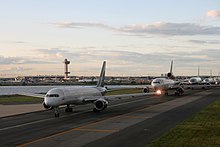
As of 2011, JFK International Airport in Queens was the busiest airport for international passengers in North America.[386]
New York City's public bus fleet and commuter rail network are the largest in North America.[369] The rail network, connecting the suburbs in the tri-state region to the city, consists of the Long Island Rail Road, Metro-North Railroad and New Jersey Transit. The combined systems converge at Grand Central Terminal and Pennsylvania Station and contain more than 250 stations and 20 rail lines.[369][388]
New York City is the top international air passenger gateway to the United States.[389] The area is served by three major airports, John F. Kennedy International, Newark Liberty International, and LaGuardia; 100 million travelers used the three airports in 2005, and the city's airspace is the busiest in the nation.[390] Outbound international travel from JFK and Newark accounted for about a quarter of all U.S. travelers who went overseas in 2004.[391] Plans have advanced to expand passenger volume at a fourth airport, Stewart International Airport near Newburgh, New York, by the Port Authority of New York and New Jersey.[392]

The Verrazano-Narrows Bridge, one of the world's longest suspension bridges,[382][383] connects Brooklyn and Staten Island across The Narrows.
To complement New York's vast mass transit network, the city also has an extensive web of expressways and parkways, that link New York City to northern New Jersey, Westchester County, Long Island, and southwestern Connecticut through various bridges and tunnels. Because these highways serve millions of suburban residents who commute into New York City, it is quite common for motorists to be stranded for hours in traffic jams that are a daily occurrence, particularly during rush hour.[399]
Despite New York's reliance on public transit, roads are a defining feature of the city. Manhattan's street grid plan greatly influenced the city's physical development. Several of the city's streets and avenues, like Broadway,[400] Wall Street,[401] Madison Avenue,[402][403] and Seventh Avenue are also used as metonyms for national industries located there: the theater, finance, advertising, and fashion organizations, respectively.
Military
New York City is home to Fort Hamilton, the U.S. military's only active duty installation within the city.[404] Established in 1825 in Brooklyn on the site of a small battery utilized during the American Revolution, it is one of America's longest serving military forts.[405] Today Fort Hamilton serves as the headquarters of the North Atlantic Division, United States Army Corps of Engineers, as well as the New York City Recruiting Battalion. It also houses the 1179th Transportation Brigade, the 722nd Aeromedical Staging Squadron, and a Military Entrance Processing Station.Other formerly active military reservations still utilized for military training or reserve and National Guard operations in the city include Fort Wadsworth in Staten Island and Fort Totten in Queens.
Global outreach
Historic sister cities
New York City has eleven historic sister cities:[406]| City | Since |
|---|---|
| 1960 | |
| 1980 | |
| 1982 | |
| 1982 | |
| 1983 | |
| 1992[407] | |
| 1992 | |
| 1993 | |
| 2001[408] | |
| 2003 | |
| 2004 [409] |
New York City Global Partners network
In 2006, the Sister City Program of the City of New York, Inc. was restructured and renamed New York City Global Partners. New York City has expanded its international outreach via this program to a network of cities worldwide, promoting the exchange of ideas and innovation between their citizenry and policymakers, according to the city's website. The list of historic sister cities above was consolidated into the Global Partners network and joined by the cities below,[406] including Chongqing (Chungking), Jakarta, Kuala Lumpur and Tel Aviv (four "non-historic" sister cities of New York).| [show]Global Partners of New York City |
|---|
See also
Notes
References
- ^ Jump up to: a b "US Gazetteer files: 2010, 2000, and 1990". United States Census Bureau. 2011-02-12. Retrieved 2011-04-23.
- Jump up ^ the Mayor, New York City Office of (January 8, 2010). "Biography". New York, City of. Retrieved 2010-01-08.
- Jump up ^ "US Board on Geographic Names". United States Geological Survey. 2007-10-25. Retrieved 2008-01-31.
- ^ Jump up to: a b c d e f g "U.S. Census Bureau 2012 estimate: NYC & NY". Retrieved 2013-07-10.
- Jump up ^ "American FactFinder". United States Census Bureau. Retrieved 2008-01-31.
- Jump up ^
- "World's Largest Urban Areas [Ranked by Urban Area Population]". Rhett Butler. 2003–2006. Retrieved 2011-04-26.
- "Largest Cities of the World – (by metro population)". Woolwine-Moen Group d/b/a Graphic Maps. Retrieved 2011-04-26.
- "Largest Urban Areas in the World: 2008 All Urban Areas 2,000,000 & Over". Wendell Cox Consultancy. Retrieved 2011-04-26.
- Jump up ^ "Welcome to the official New York City Web Site". The City of New York. 2011. Retrieved 2011-09-18.
- Jump up ^ "All Municipality Websites Listed Alphabetically". New York State. Retrieved 2011-09-18.
- Jump up ^ "GLOBAL POWER CITY INDEX 2009". The Mori Memorial Foundation. Retrieved 2012-06-01.
- Jump up ^ "United Nations Visitors Centre". United Nations. 2011. Retrieved 2011-04-26.
- Jump up ^ "Office of the Mayor Commission for the United Nations, Consular Corps and Protocol". The City of New York. 2012. Retrieved 2012-02-05.
- ^ Jump up to: a b
- "Consulate General of Iceland New York Culture". Consulate General of Iceland New York. Retrieved 2013-02-17.
- "Consulate of Latvia in New York". Consulate of Latvia. Retrieved 2013-02-17.
- "Introduction to Chapter 14: New York City (NYC) Culture". The Weissman Center for International Business Baruch College/CUNY 2011. Retrieved 2013-02-17.
- ^ Jump up to: a b "New York, Culture Capital of the World, 1940–1965 / edited by Leonard Wallock ; essays by Dore Ashton ... [et al.]". NATIONAL LIBRARY OF AUSTRALIA. Retrieved 2013-02-17.
- Jump up ^ "How The Earth Was Made". A&E Television Networks, LLC. Retrieved 2011-09-19.
- Jump up ^ "Boroughs of New York City". Ben Cahoon. 2002. Retrieved 2012-02-03.
- Jump up ^ "A 5-Borough Centennial Preface for Katharine Bement Davis Mini-History". The New York City Department of Correction. 1997. Retrieved 2011-10-26.
- Jump up ^ "New York: A City of Neighborhoods". New York City Department of City Planning. Retrieved 2011-04-30.
- ^ Jump up to: a b County and City Data Book:2007 (U.S. Census Bureau), Table B-1, Area and Population, Retrieved 2008-07-12.
- Jump up ^ "Endangered Language Alliance". 2012. Retrieved September 7, 2013.
- Jump up ^ Roberts, Sam (April 28, 2010). "Listening to (and Saving) the World's Languages". The New York Times. Retrieved 2010-04-29.
- Jump up ^ "Linguistics- Say what?". The Economist. September 10, 2011. Retrieved October 24, 2013.
- Jump up ^ "Geographic area,"April 1, 2010",,Population estimates (as of July 1),, ,,,Census,Estimates base,2010,2011,2012". U.S. Census Bureau. Retrieved October 27, 2013.
- Jump up ^ "ACS DEMOGRAPHIC AND HOUSING ESTIMATES Geographies - 2012 American Community Survey 1-Year Estimates New York-Newark-Bridgeport, NY-NJ-CT-PA CSA". U.S. Census Bureau. Retrieved October 27, 2013.
- ^ Jump up to: a b "United States History - History of New York City, New York". Retrieved 2012-09-09.
- Jump up ^ Shorto, Russell (2005). The Island at the Center of The World, 1st Edition. New York: Vintage Books. p. 30. ISBN 1-4000-7867-9.
- Jump up ^ "New Jersey Colony Reading Comprehension". MrNussbaum.com. Retrieved 2012-09-09.
- Jump up ^ "KINGSTON Discover 300 Years of New York History DUTCH COLONIES". National Park Service, U.S. Department of the Interior. Retrieved 2011-05-10.
- Jump up ^ "The Nine Capitals of the United States". United States Senate. Retrieved 2008-09-07.
- Jump up ^ "Rank by Population of the 100 Largest Urban Places, Listed Alphabetically by State: 1790–1990". U.S. Census Bureau. June 15, 1998. Retrieved 2009-02-08.
- Jump up ^ "Statue of Liberty". A&E Television Networks, LLC. Retrieved 2011-05-21.
- Jump up ^ "Statue of Liberty". World Heritage. UNESCO World Heritage Centre 1992–2011. Retrieved 2011-10-23.
- Jump up ^ Patrick McGeehan (December 20, 2011). "As City Closes In on 50 Millionth Visitor, British Couple to Be Feted". The New York Times. Retrieved 2011-12-21.
- Jump up ^ "NYC reaches goal of 50 million tourists". North Jersey Media Group. December 20, 2011. Retrieved 2011-12-21.
- Jump up ^ "NYC The Official Guide nycgo.com – nyc statistics". NYC & Company. Retrieved 2011-09-16.
- Jump up ^ "Big Apple History Arts and Entertainment The Crossroads of the World". Thirteen/WNET New York 2005 Educational Broadcasting Corporation. Retrieved 2011-04-26.
- Jump up ^ "Crossroads of the world – Times Square the official website of Times Square". Times Square District Management Association, Inc. Retrieved 2011-04-26.
- Jump up ^ "Times Square New York, NY Times Square". 2011 NYCTourist.com. Retrieved 2011-05-10.
- Jump up ^ Aditya Rangroo (October 14, 2010). "Times Square Crossroads of the World New York City Info". (C) 1980–2010 TimesSquare.com A Dataware Corporation Company. Retrieved 2012-01-22.
- Jump up ^ Allan Tannenbaum. "New York in the 70s: A Remembrance". The Digital Journalist. Retrieved 2011-12-17.
- Jump up ^ "Times Square". Encyclopædia Britannica. Retrieved 2011-05-10.
- ^ Jump up to: a b Joshua Pramis (October 2011). "World's Most-Visited Tourist Attractions No. 1: Times Square, New York City". American Express Publishing Corporation. Retrieved 2012-03-29.
- Jump up ^ "The Most Jivin' Streetscapes in the World". Luigi Di Serio. 2010. Retrieved 2011-05-10.
- Jump up ^ "New York Architecture Images- Midtown Times Square". 2011 nyc-architecture. Retrieved 2011-05-10.
- Jump up ^ "Buildings in New York City". Council on Tall Buildings and Urban Habitat. Retrieved 2011-06-08.
- Jump up ^ "UBS may move US investment bank to NYC". e-Eighteen.com Ltd. June 10, 2011. Retrieved 2013-02-04.
- Jump up ^ Kathryn Cooper (11 November 2012). "New York ousts London as world financial capital". Times Newspapers Ltd. Retrieved 2013-02-06.
- Jump up ^ "London lags New York as world financial capital". MarketWatch, Inc. November 12, 2012. Retrieved 2013-02-04.
- Jump up ^ Richard Florida (May 8, 2012). "What Is the World's Most Economically Powerful City?". The Atlantic Monthly Group. Retrieved 2013-02-05.
- Jump up ^ "Xinhua-Dow Jones International Financial Centers Development Index (2011)". CFC Holding Company, Ltd., Index Center and CME Group Index services LLC (Dow Jones Indexes). July 8, 2011. p. 11. Retrieved 2013-02-04.
- Jump up ^ "Market Highlights for First Half-year 2010". World Federation of Exchanges. Retrieved 2011-04-13.
- Jump up ^ Morgan Brennan (March 22, 2013). "The World's Most Expensive Billionaire Cities". Forbes. Retrieved 2013-07-06.
- Jump up ^ "The World's Most Expensive Real Estate Markets". CNBC. Retrieved 2010-05-30.
- Jump up ^ Sarah Waxman. "The History of New York's Chinatown". Mediabridge Infosystems, Inc. Retrieved 2011-03-05.
- Jump up ^ "Chinatown New York City Fact Sheet". explorechinatown.com. Retrieved 2011-12-18.
- Jump up ^ David M. Reimers. Still the Golden Door: the Third .... Google Books. Retrieved 2011-12-15.
- Jump up ^ "Chinatown". Indo New York. Retrieved 2011-12-18.
- Jump up ^ Baker, Al; Pérez-Peña, Richard (December 20, 2005). "With Terrorism Concerns in Mind, Police Prepare to Guard a Shuttered System". The New York Times. Retrieved 2012-02-17.
- Jump up ^ "NYC Colleges and Universities". Mediabridge Infosystems, Inc. Retrieved 2011-10-13.
- Jump up ^ "Academic Ranking of World Universities 2013". ShanghaiRanking Consultancy. Retrieved September 10, 2013.
- Jump up ^ Evan T. Pritchard: Native New Yorkers: the legacy of the Algonquin people of New York, p.27 (2002); ISBN 1-57178-107-2
- Jump up ^ Rankin, Rebecca B., Cleveland Rodgers (1948). New York: The World's Capital City, Its Development and Contributions to Progress. Harper.
- Jump up ^ Wpa Writer's Project:A Maritime History of New York, p.246;Going Coastal Productions (2004) ISBN 0-9729803-1-8
- Jump up ^ Roberts, Sam (October 2, 2012). "Honoring a Very Early New Yorker". New York Times.
- Jump up ^ Juan Rodriguez monograph. Ccny.cuny.edu. Retrieved 2013-07-12.
- Jump up ^ Dutch Colonies, National Park Service. Accessed 2007-05-19. "Sponsored by the West India Company, 30 families arrived in North America in 1624, establishing a settlement on present-day Manhattan."
- Jump up ^ Tolerance Park Historic New Amsterdam on Governors Island[dead link], Tolerance Park. Accessed 2007-05-12. See Legislative Resolutions Senate No. 5476 and Assembly No. 2708.
- Jump up ^ Frederick M. Binder, David M. Reimers: All the Nations Under Heaven: An Ethnic and Racial History of New York City, p.4;(1996)ISBN 0-231-07879-X
- Jump up ^ Pieter Schaghen Letter 1626: "... hebben t'eylant Manhattes van de wilde gekocht, voor de waerde van 60 gulden: is groot 11000 morgen. ... "("... They have purchased the Island Manhattes from the Indians for the value of 60 guilders. It is 11,000 morgens in size ...)
- Jump up ^ "Value of the Guilder / Euro". International Institute of Social History. Retrieved 2008-08-19.
- Jump up ^ "Letter describing purchase by Pieter Schaghen from Dutch National Archive, The Hague, with transcription". Nnp.org. Retrieved 2010-10-28.
- Jump up ^ Miller, Christopher L; Hamell, George R (September 1986). "A New Perspective on Indian-White Contact: Cultural Symbols and Colonial Trade". The Journal of American History (Organization of American Historians) 73 (2): 311–328. doi:10.2307/1908224. JSTOR 1908224.
- Jump up ^ Homberger, Eric (2005). The Historical Atlas of New York City: A Visual Celebration of 400 Years of New York City's History. Owl Books. p. 34. ISBN 0-8050-7842-8.
- Jump up ^ "Native Americans". Penn Treaty Museum.
- Jump up ^ "Gotham Center for New York City History" Timeline 1700–1800
- Jump up ^ "Timeline of Yellow Fever in America". Public Broadcasting Service (PBS).
- Jump up ^ "The Early History of Yellow Fever" (PDF). Pedro Nogueira, Thomas Jefferson University. 2009.
- Jump up ^ Adele Oltman (October 24, 2005). "The Hidden History of Slavery in New York". The Nation. Retrieved 2013-07-09.
- Jump up ^ Moore, Nathaniel Fish (1876). An Historical Sketch of Columbia College, in the City of New York, 1754–1876. Columbia College. p. 8.
- Jump up ^ Trinity Church bicentennial celebration, May 5, 1897 By Trinity Church (New York, N.Y.) p. 37
- Jump up ^ "The People's Vote: President George Washington's First Inaugural Speech (1789)". U.S. News and World Report. Retrieved 2008-09-01.
- Jump up ^ Shorto, Russell (February 9, 2004). "The Streets Where History Lives". The New York Times. Retrieved 2013-06-19.
- Jump up ^ Douglas Harper (2003). "Slavery in the North - Emancipation in New York". Retrieved 2013-02-06.
- ^ Jump up to: a b c New York Divided: Slavery and the Civil War online exhibit, New-York Historical Society, (November 17, 2006 to September 3, 2007, physical exhibit), accessed 2012-05-10
- Jump up ^ Leslie M. Harris, "African Americans in New York City, 1626–1863", Department of History, Emory University
- Jump up ^ Ira Rosenwaike (1972).Population History of New York City, p.55.
- Jump up ^ Bridges, William (181 1). Map Of The City Of New York And Island Of Manhattan With Explanatory Remarks And References.; Lankevich (1998), pp. 67–68.
- Jump up ^ Mushkat, Jerome Mushkat (1990). Fernando Wood: A Political Biography. Kent State University Press. p. 36. ISBN 0-87338-413-X.
- Jump up ^ "Cholera in Nineteenth Century New York". VNY, City University of New York.
- ^ Jump up to: a b c Leslie M. Harris, "The New York City Draft Riots", excerpt from In the Shadow of Slavery: African Americans in New York City, 1626-1863, University of Chicago Press, 2003
- Jump up ^ Cook, Adrian (1974). The Armies of the Streets: The New York City Draft Riots of 1863. pp. 193–195.
- Jump up ^ The 100 Year Anniversary of the Consolidation of the 5 Boroughs into New York City, New York City. Retrieved 2007-06-29
- Jump up ^ "Cornell University Library: Triangle Factory Fire". Cornell University. Retrieved 2008-09-01.
- Jump up ^ Ira Rosenwaike (1972).Population History of New York City, p.78.
- Jump up ^ "Workforce Diversity The Stonewall Inn, National Historic Landmark National Register Number: 99000562". National Park Service, U.S. Department of the Interior. Retrieved 2011-05-01.
- Jump up ^ "New York Urbanized Area: Population & Density from 1800 (Provisional)". Demographia.com. Retrieved 2009-07-08.
- Jump up ^ Allen, Oliver E. (1993). "Chapter 9: The Decline". The Tiger – The Rise and Fall of Tammany Hall. Addison-Wesley Publishing Company. ISBN 0-201-62463-X.
- Jump up ^ Burns, Ric (August 22, 2003). "The Center of the World – New York: A Documentary Film (Transcript)". PBS. Retrieved 2008-09-01.
- Jump up ^ Allan Tannenbaum. "New York in the 70s: A Remembrance". The Digital Journalist. Retrieved 2011-12-18.
- Jump up ^ Christopher Effgen (September 11, 2001). "New York Crime Rates 1960–2009". Disastercenter.com. Retrieved 2010-10-28.
- Jump up ^ "Missing Doctor Added to List of 9/11 Victims". TWO SL LLC, New York, NY. Associated Press. July 2008. Retrieved 2013-02-21.
- Jump up ^ "Report: WTC Faces Up To 3-Year Delay". Associated Press via New York Post. (New York, New York). June 30, 2008. Retrieved 2008-07-05.[dead link]
- Jump up ^ "Project Updates: World Trade Center Transportation Hub". Lower Manhattan Construction Command Center. Retrieved 2012-06-01.
- Jump up ^ "New York City Skyscraper Diagram". Skyscraper Source Media. Retrieved 2013-01-22.
- Jump up ^ "World Skyscraper Construction 2013". Skyscraper Source Media. Retrieved 2013-01-22.
- Jump up ^ Laura Matthews (2012-04-30). "One World Trade Center On Top As Tallest Building In New York City". The International Business Times. Retrieved 2013-01-22.
- Jump up ^ Benjamin Lesser (April 30, 2012). "It’s official: 1 World Trade Center is now New York's tallest skyscraper". Daily News. New York. Retrieved 2013-01-22.
- Jump up ^ Washington, D.C. is 228 miles (367 km) driving distance from New York, and Boston is 217 miles (349 km) driving distance from New York. – Google Maps
- Jump up ^ "Information About the Hudson River Estuary". Life.bio.sunysb.edu. Retrieved 2011-08-20.
- Jump up ^ Berger, Joseph (July 19, 2010). "Reclaimed Jewel Whose Attraction Can Be Perilous". New York Times. Retrieved 2010-07-21.
- Jump up ^ Gillespie, Angus K. (1999). Twin Towers: The Life of New York City's World Trade Center. Rutgers University Press. p. 71. ISBN 0-7838-9785-5.
- Jump up ^ Lopate, Phillip (2004). Waterfront: A Walk Around Manhattan. Anchor Press. ISBN 0-385-49714-8.
- Jump up ^ "NYC Profile" (PDF). New York City Department of City Planning. Retrieved 2008-05-22.
- Jump up ^ Roberts, Sam (May 22, 2008). "It's Still a Big City, Just Not Quite So Big". The New York Times. Retrieved 2008-05-22.
- Jump up ^ Lundrigan, Margaret (2004). Staten Island: Isle of the Bay, NY. Arcadia Publishing. p. 10. ISBN 0-7385-2443-3.
- Jump up ^ Howard, David (2002). Outside Magazine's Urban Adventure New York City. W. W. Norton & Company. p. 35. ISBN 0-393-32212-2.
- Jump up ^ Mary Johnson (October 29, 2012). "VIDEO: Dramatic Explosion at East Village Con Ed Plant". DNAinfo.com. Retrieved 2012-11-27.
- ^ Jump up to: a b Peel, M. C.; Finlayson, B. L.; McMahon, T. A. "World Map of Köppen-Geiger climate classification". The University of Melbourne. Retrieved 2013-04-26.
- ^ Jump up to: a b "New York Polonia Polish Portal in New York". NewYorkPolonia.com. Retrieved 2013-04-26.
- ^ Jump up to: a b "Average Percent Sunshine through 2009". National Climatic Data Center. Retrieved 2012-11-14.
- Jump up ^ "united states annual sunshine map". HowStuffWorks, Inc. Retrieved 2011-03-19.
- Jump up ^ "The Climate of New York". New York State Climate Office. Retrieved 2012-07-06.
- ^ Jump up to: a b "Weatherbase New York, New York". Canty and Associates LLC. Retrieved 2012-09-03.
- Jump up ^ "Monthly Weather Averages and Records for New York, NY". Weather.com. 2013-01-14. Retrieved 2013-05-04.
- Jump up ^ Sam Dolnick (August 28, 2011). "Damage From Irene Largely Spares New York – Recovery Is Slower in New York Suburbs". The New York Times. Retrieved 2013-01-26.
- Jump up ^ "Superstorm Sandy blamed for at least 11 U.S. deaths as it slams East Coast". CNN. 2012-10-29. Retrieved 2013-01-22.
- Jump up ^ Robert S. Eshelman (November 15, 2012). "ADAPTATION: Political support for a sea wall in New York Harbor begins to form". E&E Publishing, LLC. Retrieved 2012-12-01.
- Jump up ^ "NowData - NOAA Online Weather Data". National Oceanic and Atmospheric Administration. Retrieved 2013-03-04.
- Jump up ^ "New York Central Park, NY Climate Normals 1961−1990". NOAA.
- Jump up ^ "The Current Population of NYC (2005)" (PDF). New York City Department of City Planning. Retrieved 2007-03-13. These figures were adopted by the U.S. Census Bureau in September 2006.
- ^ Jump up to: a b The Encyclopedia of New York City, ed. Kenneth T. Jackson (Yale 1995, ISBN 0-300-05536-6), page 923, citing "U.S. Department of Commerce, Bureau of the Census, Census of Population 1960 (vol.1, part A, table 28), 1970, 1980, 1990". After annexing part of the Bronx in 1874, the population of the then-New York City was 1,206,299 in 1880 and 1,515,301 in 1890.
- Jump up ^ Greene and Harrington (1932). American Population Before the Federal Census of 1790. New York., as cited in: Rosenwaike, Ira (1972). Population History of New York City. Syracuse, N.Y.: Syracuse University Press. p. 8. ISBN 0-8156-2155-8.
- Jump up ^ U.S. Census, from The World Almanac and Book of Facts, 1929 (reprinted in 1971 by American Heritage Press and Workman Publishing, ISBN 0-07-071881-4), page 503.
- Jump up ^ Gibson, Campbell. Population of the 100 Largest Cities and Other Urban Places in the United States:1790 to 1990[dead link], United States Census Bureau, June 1998. Retrieved 2007-06-12.
- Jump up ^ U.S. Census Bureau, Population Division, Table 5. Annual Estimates of the Resident Population for Minor Civil Divisions in New York, Listed Alphabetically Within County: April 1, 2000 to July 1, 2009 (SUB-EST2009-05-36) and Table 1. Annual Estimates of the Resident Population for Incorporated Places Over 100,000, Ranked by July 1, 2009 Population: April 1, 2000 to July 1, 2009 (SUB-EST2009-01), Release Date: June 2010, Retrieved 2010-07-31
- Jump up ^ Roberts, Sam (March 24, 2011). "City Population Barely Grew in the '00s, Census Finds". The New York Times. Retrieved 2011-03-24.
- Jump up ^ Simone Weichselbaum (June 26, 2012). "Nearly one in four Brooklyn residents are Jews, new study finds". New York Daily News. Retrieved 2013-05-30.
- Jump up ^ "Annual Estimates of the Resident Population for Incorporated Places Over 50,000, Ranked by July 1, 2011 Population: April 1, 2010 to July 1, 2011". U.S. Census Bureau. Retrieved 2013-02-17.
- Jump up ^ Blake Ellis (March 25, 2011). "America's 5 biggest cities". CNN. Retrieved 2013-02-17.
- Jump up ^ Roberts, Sam (March 14, 2013). "Fewer People Are Abandoning the Bronx, Census Data Show". New York Times.
- Jump up ^ "State & County QuickFacts Los Angeles (city), California". U.S. Census Bureau. Retrieved 2013-05-29.
- Jump up ^ "State & County QuickFacts Chicago (city), Illinois". U.S. Census Bureau. Retrieved 2013-05-29.
- ^ Jump up to: a b Sam Roberts (March 24, 2011). "New York City's Population Barely Rose in the Last Decade, the Census Finds". The New York Times. Retrieved 2011-05-01.
- Jump up ^ "New York City Population Projections by Age/Sex and Borough, 2000–2030" (PDF). New York City Department of City Planning. December 2006. Retrieved 2007-03-27. See also Roberts, Sam (February 19, 2006). "By 2025, Planners See a Million New Stories in the Crowded City". New York Times. Retrieved 2006-07-19.
- Jump up ^ "New Jersey – Place and County Subdivision GCT-PH1. Population, Housing Units, Area, and Density: 2000". U.S. Census Bureau. Retrieved 2011-05-01.
- Jump up ^ "New York – County GCT-PH1. Population, Housing Units, Area, and Density: 2000". U.S. Census Bureau. Retrieved 2011-10-01.
- Jump up ^ "Population Density", Geographic Information Systems – GIS of Interest. Accessed 2007-05-17. "What I discovered is that out of the 3140 counties listed in the Census population data only 178 counties were calculated to have a population density over one person per acre. Not surprisingly, New York County (which contains Manhattan) had the highest population density with a calculated 104.218 persons per acre."
- Jump up ^ Camille Mann and Stephanie Valera. "World's Most Crowded Islands". The Weather Channel. Retrieved 2013-06-27.
- ^ Jump up to: a b "Chinese New Year 2012 in Flushing". QueensBuzz.com. January 25, 2012. Retrieved 2013-04-02.
- Jump up ^ Charisse Jones (September 24, 2008). "Ellis Island strives to tell more complete immigration story". USA Today. Retrieved 2013-02-04.
- Jump up ^
 Chisholm, Hugh, ed. (1911). "New York City#Population". Encyclopædia Britannica 19 (11th ed.). Cambridge University Press. p. 617
Chisholm, Hugh, ed. (1911). "New York City#Population". Encyclopædia Britannica 19 (11th ed.). Cambridge University Press. p. 617 - Jump up ^ "Race and Hispanic Origin for Selected Cities and Other Places: Earliest Census to 1990". U.S. Census Bureau.
- ^ Jump up to: a b Kirk Semple (June 8, 2013). "City's Newest Immigrant Enclaves, From Little Guyana to Meokjagolmok". The New York Times. Retrieved 2013-06-12.
- Jump up ^ "The Newest New Yorkers: 2000" (PDF). New York City Department of City Planning. 2005. Retrieved 2008-09-01.
- Jump up ^ "Appendix Table 5-4: Ten Largest Sources of the Foreign-Born by County New York Metropolitan Region, 2000" (PDF). New York City Department of City Planning. 2005. Retrieved 2007-03-26.
- Jump up ^ "Yearbook of Immigration Statistics: 2012 Supplemental Table 2". U.S. Department of Homeland Security. Retrieved 2013-04-02.
- Jump up ^ "Yearbook of Immigration Statistics: 2011 Supplemental Table 2". U.S. Department of Homeland Security. Retrieved 2012-04-26.
- Jump up ^ "Yearbook of Immigration Statistics: 2010 Supplemental Table 2". U.S. Department of Homeland Security. Retrieved 2012-04-26.
- Jump up ^ "Yearbook of Immigration Statistics: 2009 Supplemental Table 2". U.S. Department of Homeland Security. Retrieved 2012-04-26.
- Jump up ^ Ian Gordon, Tony Travers, and Christine Whitehead, London School of Economics and Political Science (July 2007). "The Impact of Recent Immigration on the London Economy". The City of London Corporation. Retrieved September 8, 2013.
- Jump up ^ "World Jewish Population". SimpleToRemember.com – Judaism Online. Retrieved 2012-09-02.
- ^ Jump up to: a b "Profile of General Population and Housing Characteristics: 2010 Demographic Profile Data Geography: New York-Newark-Bridgeport, NY-NJ-CT-PA CSA". Retrieved 2012-09-02.
- Jump up ^ "Profile of General Population and Housing Characteristics: 2010 Demographic Profile Data Geography: United States". U.S. Census Bureau. Retrieved 2012-09-02.
- ^ Jump up to: a b c "Yearbook of Immigration Statistics: 2011 Supplemental Table 2". U.S. Department of Homeland Security. Retrieved 2013-02-24.
- Jump up ^ Kirk Semple (June 23, 2011). "Asian New Yorkers Seek Power to Match Numbers". The New York Times Company. Retrieved 2012-09-02.
- Jump up ^ "Yearbook of Immigration Statistics: 2012 Supplemental Table 2". U.S. Department of Homeland Security. Retrieved 2013-03-24.
- Jump up ^ "Yearbook of Immigration Statistics: 2010 Supplemental Table 2". U.S. Department of Homeland Security. Retrieved 2013-02-24.
- Jump up ^ John Marzulli (May 9, 2011). "Malaysian man smuggled illegal Chinese immigrants into Brooklyn using Queen Mary 2: authorities". New York: The New York Daily News. Retrieved 2013-02-24.
- Jump up ^ Kirk Semple (June 23, 2011). "Asian New Yorkers Seek Power to Match Numbers". The New York Times. Retrieved 2011-07-05. "Asians, a group more commonly associated with the West Coast, are surging in New York, where they have long been eclipsed in the city's kaleidoscopic racial and ethnic mix. For the first time, according to census figures released in the spring, their numbers have topped one million—nearly 1 in 8 New Yorkers—which is more than the Asian population in the cities of San Francisco and Los Angeles combined."
- Jump up ^ "Asian American Statistics". Améredia Incorporated. Retrieved 2011-07-05.
- Jump up ^ "Table SF1-P9 NYC: Total Asian Population by Selected Subgroups". NYC.gov. Retrieved 2011-08-27.
- Jump up ^ "Dominicans in America". DR1. Retrieved September 7, 2013.
- Jump up ^ Moore LT, McEvoy B, Cape E, Simms K, Bradley DG (February 2006). "A Y-Chromosome Signature of Hegemony in Gaelic Ireland" (PDF). The American Journal of Human Genetics 78 (2): 334–338. doi:10.1086/500055. PMC 1380239. PMID 16358217. Retrieved 2007-06-07.[dead link] See also Wade, Nicholas (January 18, 2006). "If Irish Claim Nobility, Science May Approve". The New York Times. Retrieved 2006-07-16.
- Jump up ^ O'Neill; McLaughlin (2006). "Insights Into the O'Neills of Ireland from DNA Testing". Journal of Genetic Genealogy.
- Jump up ^ Gary J. Gates, PhD. "Same-sex Couples and the Gay, Lesbian, Bisexual Population: New Estimates from the American Community Survey". The Williams Institute on Sexual Orientation. Retrieved 2012-09-02.
- Jump up ^ Nicholas Confessore and Michael Barbaro (June 24, 2011). "New York Allows Same-Sex Marriage, Becoming Largest State to Pass Law". The New York Times Company. Retrieved 2012-09-02.
- Jump up ^ Roberts, Sam (April 9, 2005). "In Manhattan, Poor Make 2 Cents for Each Dollar to the Rich". The New York Times. Retrieved 2007-03-27.[dead link]
- Jump up ^ "County Employment and Wages Summary". Bureau of Labor Statistics, U.S. Department of Labor. September 26, 2013. Retrieved 2013-11-08.
- Jump up ^ "The 20 Cities Where The Most Billionaires Live". Business Insider. 2013-05-07.
- Jump up ^ "Mumbai sixth among top 10 global cities on billionaire count". Times of India. 2013-05-10.
- Jump up ^ "Which cities do the world's millionaires and billionaires live in?". The Guardian. 2013-05-08.
- Jump up ^ "The World's Billionaires - Michael Bloomberg". Forbes.com. Retrieved 2013-02-24.
- Jump up ^ Roberts, Sam (March 27, 2007). "In Surge in Manhattan Toddlers, Rich White Families Lead Way". The New York Times. Retrieved 2013-06-07.
- Jump up ^ "As One World Trade Center soars, so do its costs". msnbc.com. Retrieved 2012-02-01.[dead link]
- Jump up ^ "Emporis Skyline Ranking". Emporis Corporation. Retrieved 2011-10-23.
- Jump up ^ "Emporis Skyline Ranking". Emporis Corporation. Retrieved 2011-10-23.
- Jump up ^ Fischler, Raphael (1998). "The Metropolitan Dimension of Early Zoning: Revisiting the 1916 New York City Ordinance". Journal of the American Planning Association 64 (2).
- Jump up ^ "Favorites! 100 Experts Pick Their top 10 New York Towers". The Skyscraper Museum. January 22, 2006. Retrieved 2008-09-01.
- ^ Jump up to: a b Pogrebin, Robin (April 16, 2006). "7 World Trade Center and Hearst Building: New York's Test Cases for Environmentally Aware Office Towers". The New York Times. Retrieved 2008-09-01.
- Jump up ^ Plunz, Richard A. (1990). "Chapters 3 [Rich and Poor] & 4 [Beyond the Tenement]". History of Housing in New York City: Dwelling Type and Change in the American Metropolis. Columbia University Press. ISBN 0-231-06297-4.
- Jump up ^ "If You're Thinking of Living In/Riverdale, the Bronx; A Community Jealous of Its Open Space". The New York Times. March 1, 1998. Retrieved 2012-02-10.
- Jump up ^ "New York Metro: 6 Affordable Neighborhoods". Nymag.com. September 17, 2001. Retrieved 2012-02-10.
- Jump up ^ "If You're Thinking of Living In/Douglaston, Queens; Timeless City Area, With a Country Feel". The New York Times. February 8, 2004. Retrieved 2012-02-10.
- Jump up ^ Lankevich (1998), pp. 82–83; Wilson, Rufus Rockwell (1902). New York: Old & New: Its Story, Streets, and Landmarks. J.B. Lippincott. p. 354.
- Jump up ^ Elliot, Debbie (December 2, 2006). "Wondering About Water Towers". National Public Radio. Retrieved 2008-09-01.
- Jump up ^ Hood, Clifton (2004). 722 Miles: The Building of the Subways and How They Transformed New York. Johns Hopkins University Press. pp. 175–177. ISBN 0-8018-5244-7.
- Jump up ^ Foderado, Lisa W. “New York Parks Rank No. 2 in a Survey of 50 U.S. cities”. 5 June 2013. The New York Times. Retrieved 2013-07-12.
- Jump up ^ "Discover the truly wild side of New York's metropolitan area". nps.gov. Retrieved 2012-06-11.
- Jump up ^ "Workforce Diversity The Stonewall Inn, National Historic Landmark National Register Number: 99000562". National Park Service, U.S. Department of the Interior. Retrieved 2011-04-30.
- Jump up ^ "Obama inaugural speech references Stonewall gay-rights riots". North Jersey Media Group Inc. 2013-01-21. Retrieved 2013-01-21.
- Jump up ^ "New York State Office of Parks, Recreation and Historic Preservation, New York City Region". Nysparks.state.ny.us. Retrieved 2010-10-28.
- ^ Jump up to: a b "Bronx Zoo Animals & Exhibits". Wildlife Conservation Society. Retrieved 2013-06-02.
- Jump up ^ "Mayor Giuliani Announces Amount of Parkland in New York City has Passed 28,000-acre Mark". New York City Mayor's Office. February 3, 1999. Retrieved 2008-09-01.; "Beaches". New York City Department of Parks & Recreation. Retrieved 2008-09-01.
- Jump up ^ "Pelham Bay Park Virtual Tour". NYC gov http://www.nycgovparks.org. Retrieved 2012-06-08.
- Jump up ^ "City Park Facts". The Trust for Public Land, Center for City Park Excellence. June 2006. Retrieved 2008-09-01.[dead link]
- Jump up ^ Lisa W. Foderaro (October 23, 2012). "A $100 Million Thank-You for a Lifetime's Central Park Memories". The New York Times. Retrieved 2012-10-23.
- Jump up ^ "General Information". Prospect Park Alliance. Retrieved 2008-09-01.
- Jump up ^ "Flushing Meadows-Corona Park, page 46". Neighborhood Open Space Coalition. Retrieved 2012-04-14.
- Jump up ^ Ladies and gentlemen, the Bronx is blooming![dead link] by Beth J. Harpaz, Travel Editor of The Associated Press (AP), June 30, 2008, Retrieved 2008-07-11
- Jump up ^ 2011 borough population estimates are taken from the annual database of county population estimates from the U.S. Census Bureau, specifically this Microsoft Excel spreadsheet for New York state's counties, Table 1. Annual Estimates of the Resident Population for Counties of New York: April 1, 2010 to July 1, 2011, retrieved on May 13, 2012
- Jump up ^ American Fact Finder (U.S. Census Bureau): New York by County - Table GCT-PH1. Population, Housing Units, Area, and Density: 2000 Data Set: Census 2000 Summary File 1 (SF 1) 100-Percent Data, retrieved on February 6, 2009
- Jump up ^ Benjamin, Gerald, Richard P. Nathan (1990). Regionalism and realism: A Study of Government in the New York Metropolitan Area. Brookings Institute. p. 59.
- Jump up ^ Frazier, Ian (June 26, 2006). "Utopia, the Bronx". The New Yorker. Retrieved 2008-09-01.
- Jump up ^ Ward, Candace (2000). New York City Museum Guide. Dover Publications. p. 72. ISBN 0-486-41000-5.
- ^ Jump up to: a b Toop, David (1992). Rap Attack 2: African Rap to Global Hip Hop. Serpents Tail. ISBN 1-85242-243-2.
- Jump up ^ Immerso, Michael (2002). Coney Island: The People's Playground. Rutgers University Press. p. 3. ISBN 0-8135-3138-1.
- Jump up ^ O'Donnell, Michelle (July 4, 2006). "In Queens, It's the Glorious 4th, and 6th, and 16th, and 25th ...". New York Times. Retrieved 2008-09-01.
- Jump up ^ Roberts, Sam (January 10, 2006). "Black Incomes Surpass Whites in Queens". The New York Times. Retrieved 2008-09-01.
- Jump up ^ "Staten Island Greenbelt | New York-New Jersey Trail Conference". Nynjtc.org. Retrieved 2010-10-28.
- Jump up ^ "The Metropolitan Museum of Art General Information". The Metropolitan Museum of Art. Retrieved 2012-09-10.
- Jump up ^ "Consulate of Latvia in New York". Consulate of Latvia. Retrieved 2013-02-17.
- Jump up ^ "Introduction to Chapter 14: New York City (NYC) Culture". The Weissman Center for International Business Baruch College/CUNY 2011. Retrieved 2013-02-17.
- Jump up ^ "Speeches: Tom Christopher Exhibit Opening" (Press release). Consulate General of the United States: Frankfurt, Germany. May 9, 2007. Archived from the original on 2007-07-23. Retrieved 2008-09-01.
- Jump up ^ "HARLEM IN THE JAZZ AGE". New York Times. February 8, 1987. Retrieved 2012-05-31.
- Jump up ^ "ART; A 1920's Flowering That Didn't Disappear". NY Times. May 24, 1998. Retrieved 2012-05-31.
- Jump up ^ "Harlem Renaissance Music in the 1920s". http://www.1920s-fashion-and-music.com. Retrieved 2012-06-01.
- Jump up ^ "Will Gentrification Spoil the Birthplace of Hip-Hop? - New York". NY Times. May 21, 2007. Retrieved 2012-06-01.
- Jump up ^ Harrington, Joe S. Sonic Cool: The Life & Death of Rock 'N' Roll. pp. 324–30. 2002. Hal-Leonard. USA.
- Jump up ^ "SURVIVAL OF THE STREETS". Vice. Retrieved 2012-06-01.
- Jump up ^ "capital". Dictionary.com. Retrieved 2011-07-10.
- Jump up ^ "Free To Dance – About The Film". Public Broadcasting Service. Retrieved 2011-07-10.
- Jump up ^ "Group Visits". Alvin Ailey Dance Foundation, Inc. Retrieved 2011-07-10.[dead link]
- Jump up ^ Miriam Kreinin Souccar. "NYC Film Industry Second in Nation". Crain Communications. Retrieved 2012-02-08.
- Jump up ^ "New York Film Academy, New York City". New York Film Academy. Retrieved 2012-02-08.
- Jump up ^ "AICP Staff & National Offices". Association of Independent Commercial Producers. Retrieved 2012-02-08.
- ^ Jump up to: a b "Creative New York" (PDF). Center for an Urban Future. December 2005. Retrieved 2008-09-01.
- Jump up ^ Welsh, Anne Marie (June 6, 2004). "2 plays + 9 nominations=good odds for locals". San Diego Union-Tribune. Retrieved 2008-09-01.
- Jump up ^ McBeth, VR. "The Great White Way" on TimesSquare.com. Quote: "Coined in 1901 by O.J. Gude, the designer of many prominent advertising displays, to describe the new light show that beckoned along Broadway,The Great White Way is a phrase known worldwide to describe Broadway's profusion of theaters in Times Square."
- Jump up ^ Tell, Darcy. Times Square spectacular: lighting up Broadway New York: HarperCollins, 2007
- Jump up ^ Allen, Irving Lewis. The City in Slang: New York Life and Popular Speech. New York: Oxford University Press, 1995. Quote: "By 1910, the blocks of Broadway just above 42nd Street were at the very heart of the Great White Way. The glow of Times Square symbolized the center of New York, if not of the world."
- Jump up ^ "About Summer Stage". City Parks Foundation. Retrieved 2012-06-14.
- Jump up ^ "The Crossroads of the World". PBS. Retrieved 2008-01-30.
- Jump up ^ "NYC Statistics". NYC & Company. Retrieved 2010-08-21.
- Jump up ^ Jennifer Peltz, Associated Press (September 28, 2012). "NYC to get 'world's largest' Ferris wheel". NBC News. Associated Press. Retrieved 2012-09-28.
- Jump up ^ James Barron (September 27, 2012). "World's Tallest Ferris Wheel Planned for Staten Island". The New York Times. Retrieved 2012-09-28.
- Jump up ^ "New York City draws 48.7 million tourists in 2010". CNN. January 4, 2011. Retrieved 2012-01-22.
- Jump up ^ "NYC The Official Guide nycgo.com – nyc statistics". NYC & Company, Inc. Retrieved 2012-01-22.
- Jump up ^ Patrick McGeehan (December 20, 2011). "As City Closes In on 50 Millionth Visitor, British Couple to Be Feted". The New York Times. Retrieved 2012-01-22.
- Jump up ^ "NYC reaches goal of 50 million tourists". North Jersey Media Group. December 20, 2011. Retrieved 2012-01-22.
- Jump up ^ "Tampa Bay 12th Largest Media Market Now" (Press release). Tampa Bay Partnership. August 26, 2006. Retrieved 2008-09-01.
- Jump up ^ Top 10 Consolidated Agency Networks: Ranked by 2006 Worldwide Network Revenue, Advertising Age Agency Report 2007 Index (April 25, 2007). Retrieved 2007-06-08.
- ^ Jump up to: a b "Request for Expressions of Interest" (PDF). The Governors Island Preservation & Education Corporation. 2005. Archived from the original on 2008-08-02. Retrieved 2008-09-01.
- Jump up ^ "Media and Entertainment". New York City Economic Development Corporation. Archived from the original on 2008-01-28. Retrieved 2008-09-01.
- Jump up ^ "New York Daily News (American newspaper)". Britannica.com. Retrieved 2013-05-04.
- Jump up ^ Allan Nevins, The Evening Post: Century of Journalism, Boni and Liveright, 1922, page 17.
- Jump up ^ "Ethnic Press Booms In New York City". Editor & Publisher. July 10, 2002. Retrieved 2008-09-01.[dead link]
- Jump up ^ "el Diario/La Prensa: The Nation's Oldest Spanish-Language Daily". New America Media. July 27, 2005. Retrieved 2008-09-01.
- Jump up ^ "2005 is banner year for production in New York" (Press release). The City of New York Mayor's Office of Film, Theater and Broadcasting. December 28, 2005. Retrieved 2008-09-01.[dead link]
- Jump up ^ "NYC Media". Nyc.gov. Retrieved 2013-05-04.
- Jump up ^ "Community Celebrates Public Access TV's 35th Anniversary". Mnn.org. Retrieved 2010-10-28.[dead link]
- Jump up ^ "Top 30 Public Radio Subscribers: Spring 2006 Arbitron" (PDF). Radio Research Consortium. August 28, 2006. Retrieved 2008-09-01.
- Jump up ^ Strand, Oliver (July 5, 2011). "Brooklyn Market: Woodstock of Eating". The New York Times. Retrieved 2013-05-29.
- Jump up ^ Bleyer, Jennifer (May 14, 2006). "Kebabs on the Night Shift". The New York Times. Retrieved 2008-09-01.
- Jump up ^ Collins, Glenn (November 3, 2005). "Michelin Takes on the City, Giving Some a Bad Taste". The New York Times. Retrieved 2006-07-19.
- Jump up ^ Newman, Michael (2005). "New York Talk". In Wolfram, Walt; Ward, Ben. American Voices. Blackwell. pp. 82–87. ISBN 1-4051-2109-2.
- ^ Jump up to: a b c d Sontag, Deborah (February 14, 1993). "Oy Gevalt! New Yawkese An Endangered Dialect?". The New York Times. Retrieved 2007-07-08.
- ^ Jump up to: a b World's Largest Marathons, Association of International Marathons and Road Races (AIMS). Retrieved 2007-06-28.
- Jump up ^ "National Football League Company Information". Hoover's, Inc. Retrieved 2013-05-18.
- Jump up ^ "Major League Baseball Company Information". Hoover's, Inc. Retrieved 2013-05-18.
- Jump up ^ "National Basketball Association, Inc. Company Information". Hoover's, Inc. Retrieved 2013-05-18.
- Jump up ^ "National Hockey League Company Information". Hoover's, Inc. Retrieved 2013-05-18.
- Jump up ^ "Major League Soccer, L.L.C. Company Information". Hoovers, Inc. Retrieved 2013-05-18.
- Jump up ^ Esteban (October 27, 2011). "11 Most Expensive Stadiums In The World". Total Pro Sports. Retrieved 2012-09-02.
- Jump up ^ Baseball: A Film by Ken Burns; Inning 7: The Capital of Baseball (Television Documentary). PBS.
- Jump up ^ "New York Mets - TeamReport". Chicago Tribune. May 30, 2012. Retrieved 2012-05-31.
- Jump up ^ "2000S". Newyork Yankees. Retrieved 2012-05-31.
- Jump up ^ "New York Yankees: Facts, History, Stats, and Resources". The free sources. Retrieved 2012-05-31.
- Jump up ^ "How Mets, Colt .45s Grew Up To Beat The Bullies". Chicago Tribune. October 8, 1986. Retrieved 2012-05-31.
- Jump up ^ "Dodgers Timeline". Los Angeles Dodgers. Retrieved 2008-09-22.
- Jump up ^ "Historical Moments". Dodgers Giants. Retrieved 2012-05-31.
- Jump up ^ "Major League Baseball, Police Athletic League and the Brooklyn Cyclones to host free MLB Umpire Camp". MLB Press Release. 2012-05-30. Retrieved 2012-05-31.
- Jump up ^ "New ownership group for Staten Island Yankees talks about future plans". Silive. May 31, 2012. Retrieved 2012-05-17.
- Jump up ^ "Preparations Different for a Home-and-Home Contest". New York Times. December 22, 2011. Retrieved 2012-05-31.
- Jump up ^ "Owners warm up to New York/New Jersey as Super Bowl XLVIII host". NFL.com. Associated Press. May 26, 2010. Retrieved 2010-05-27. "It's the first time the league has gone to a cold-weather site that doesn't have a dome ... the NFL will wait and see how this foray into the great outdoors in winter goes. Then the league might OK another bid"
- Jump up ^ Anderson, Dave (May 14, 1995). "Sports of The Times; At Boston Garden, There's Much More Gold Than Green". New York Times. Retrieved 2008-06-17.
- Jump up ^ "Nassau Coliseum". ESPN. Retrieved 2012-05-31.
- Jump up ^ "Islanders Moving to Brooklyn". 2012-10-24. Retrieved 2012-10-24.
- Jump up ^ "Devils' dance with Kings in Stanley Cup Finals gives Newark a spotlight". Nj.com. May 31, 2012. Retrieved 2012-05-31.
- Jump up ^ "Postseason Overview". National Invitation Tournament. Archived from the original on 2008-07-24. Retrieved 2008-09-01.
- Jump up ^ "Picture-perfect opening for $200M Red Bull Arena in Harrison". Associated Press. March 20, 2010.
- Jump up ^ Associated Press, Fox Sports Interactive Media (May 21, 2013). "Man City, Yankees to own MLS club". Retrieved 2013-05-21.
- Jump up ^ "CHAMPIONS (year by year history)". US Open. Retrieved 2012-05-31.
- Jump up ^ "Boxer Johnny Tapia's 'crazy life' ends". CNN. May 31, 2012. Retrieved 2012-05-28.
- Jump up ^ Sas, Adrian (Producer) (2006). It's my Park: Cricket (TV-Series). New York City: New York City Department of Parks & Recreation.
- Jump up ^ Fortune, Volume 167, Number 7 (May 20, 2013), page F-44
- Jump up ^ Sassen, Saskia (2001). The Global City: New York, London, Tokyo (2nd ed.). Princeton University Press. ISBN 0-691-07063-6.
- Jump up ^ Richard Florida (2012-05-08). "What Is the World's Most Economically Powerful City?". The Atlantic Monthly Group. Retrieved 2012-11-21.
- Jump up ^ "Gross Metropolitan Product". Greyhill Advisors. Retrieved 2011-10-06.
- Jump up ^ "London vs. New York, 2005–06" (PDF). Cinco Dias. Retrieved 2008-03-11.
- Jump up ^ "London may have the IPOs ...". Marketwatch. Retrieved 2009-08-30.
- Jump up ^ Dubner, Stephen J. (February 7, 2008). "Is New York Still the Financial Capital of the World?". New York Times. Retrieved 2009-08-30.
- Jump up ^ "Market highlights for first half-year 2010". World Federation of Exchanges. Retrieved 2011-05-01.
- Jump up ^ Michelle Kaske (March 12, 2012). "New York City Tops Global Competitiveness, Economist Report Says". Bloomberg L.P. Retrieved 2012-03-13.
- Jump up ^ Sharanya Hrishikesh and Ashutosh Pandey (2012-07-03). "Manchester United picks NYSE for U.S. public offering". Thomson Reuters. Retrieved 2012-07-04.
- Jump up ^ Fortune 500 web site (cities), retrieved 2011-07-21; Fortune, Vol. 163, no. 7 (May 23, 2011), page F-45
- Jump up ^ Wylde, Kathryn (January 23, 2006). "Keeping the Economy Growing". Gotham Gazette. Retrieved 2008-09-01.
- Jump up ^ Walls, Jacqueline (April 8, 2013). "American Cities of the Future 2013-14". fDiIntelligence.com. Retrieved 2013-08-05.
- ^ Jump up to: a b "Tentative Assessment Roll: Fiscal Year 2008" (PDF). New York City Department of Finance. January 15, 2007. Retrieved 2008-09-01.[dead link]
- Jump up ^ Quirk, James. "Bergen offices have plenty of space". Archived from the original on 2007-12-22., The Record (Bergen County), July 5, 2007. Accessed 2007-07-05. "On Monday, a 26-year-old, 33-story office building at 450 Park Ave. sold for a stunning $1,589 per square foot, or about $510 million. The price is believed to be the most ever paid for a U.S. office building on a per-square-foot basis. That broke the previous record—set four weeks earlier—when 660 Madison Ave. sold for $1,476 a square foot."
- Jump up ^ "NYC Film Statistics". Mayor's Office of Film, Theatre, and Broadcasting. Archived from the original on 2008-02-14. Retrieved 2008-09-01.
- Jump up ^ Currid, Elizabeth (2006). "New York as a Global Creative Hub: A Competitive Analysis of Four Theories on World Cities". Economic Development Quarterly 20 (4): 330–350. doi:10.1177/0891242406292708.
- Jump up ^ "Telecommunications and Economic Development in New York City: A Plan for Action" (PDF). New York City Economic Development Corporation. March 2005. Archived from the original on 2008-03-07. Retrieved 2006-07-19.
- Jump up ^ "Protecting and Growing New York City's Industrial Job Base" (PDF). The Mayor's Office for Industrial and Manufacturing Business. January 2005. Retrieved 2008-09-01.[dead link]
- ^ Jump up to: a b "More Than a Link in the Food Chain" (PDF). The Mayor's Office for Industrial and Manufacturing Business. February 2007. Retrieved 2008-09-01.[dead link]
- Jump up ^ "What is an office condominium?". Rudder Property Group. Retrieved 2013-05-28.
- Jump up ^ "Understanding The Manhattan Office Space Market". Officespaceseeker.com. Retrieved 2013-05-18.
- Jump up ^ "Marketbeat United States CBD Office Report 2Q11". Cushman & Wakefield, Inc. Retrieved 2013-05-18.
- Jump up ^ Claessens, Stjin (September 2000). "Electronic Finance: Reshaping the Financial Landscape Around the World" (PDF). The World Bank. Archived from the original on 2008-08-04. Retrieved 2008-09-01.
- Jump up ^ Orr, James and Giorgio Topa (Volume 12, Number 1, January 2006). "Challenges Facing the New York Metropolitan Area Economy" (PDF). Current Issues in Economics and Finance – Second District Highlights. New York Federal Reserve. Retrieved 2008-09-01.
- Jump up ^ Ambereen Choudhury, Elisa Martinuzzi & Ben Moshinsky (November 26, 2012). "London Bankers Bracing for Leaner Bonuses Than New York". Bloomberg L.P. Retrieved 2013-02-09.
- Jump up ^ David Enrich, Jacob Bunge, and Cassell Bryan-Low (2013-07-09). "NYSE Euronext to Take Over Libor". The Wall Street Journal. Retrieved 2013-07-10.
- Jump up ^ http://www.uselectionatlas.org/RESULTS/state.php?fips=36&f=0&off=99
- Jump up ^ "Forms of Municipal Government". National League of Cities. Retrieved 2012-02-10.[dead link]
- Jump up ^ "About the Council". New York City Council. Archived from the original on 2007-12-08. Retrieved 2007-06-06.
- Jump up ^ Sewell Chan and Jonathan P. Hicks (October 23, 2008). "Council Votes, 29 to 22, to Extend Term Limits". The New York Times. Retrieved 2012-02-13.
- Jump up ^ "Statement and Return Report for Certification: General Election 2005" (PDF). New York City Board of Elections. November 8, 2005. Retrieved 2008-09-01.[dead link]
- Jump up ^ Michael Barbaro and David W. Chen (November 5, 2013). "De Blasio Is Elected New York City Mayor". The New York Times. Retrieved November 6, 2013.
- Jump up ^ "NYSVoter Enrollment by County, Party Affiliation and Status". New York State Board of Elections. November 2008. Retrieved 2009-02-08.
- Jump up ^ "Financial Control Board". State of New York. Retrieved October 24, 2013.
- Jump up ^ "New York State Financial Control Board". Retrieved 2012-05-28.
- Jump up ^ "2006 Election Overview: Top Zip Codes". Opensecrets.org. Retrieved 2008-09-01.
- Jump up ^ "A Fair Share of State Budget: Does Albany Play Fair with NYC?". New York City Finance Division. March 11, 2005. Archived from the original on 2008-05-25. Retrieved 2008-09-01.
- ^ Jump up to: a b Jervey, Ben (2006). The Big Green Apple: Your Guide to Eco-Friendly Living in New York City. Globe Pequot Press. ISBN 0-7627-3835-9.
- Jump up ^ "A Better Way to Go: Meeting America's 21st Century Transportation Challenges with Modern Public Transit" (PDF). U.S. Public Interest Research Group. March 2008. Retrieved 2008-04-23.[dead link]
- Jump up ^ Owen, David (October 18, 2004). "Green Manhattan". The New Yorker.
- ^ Jump up to: a b "Inventory of New York City Greenhouse Gas Emissions" (PDF). New York City Office of Long-term Planning and Sustainability. April 2007. Retrieved 2008-09-01.
- Jump up ^ "Global Warming and Greenhouse Gases". PlaNYC/The City of New York. December 6, 2006. Retrieved 2008-09-01.[dead link]
- Jump up ^ Coburn, Jason, Jeffrey Osleeb, Michael Porter (June 2006). "Urban Asthma and the Neighbourhood Environment in New York City". Health & Place 12 (2): 167–179. doi:10.1016/j.healthplace.2004.11.002. PMID 16338632.
- Jump up ^ DePalma, Anthony (December 11, 2005). "It Never Sleeps, But It's Learned to Douse the Lights". The New York Times. Retrieved 2008-09-01.
- Jump up ^ "A Century of Buses in New York City". Metropolitan Transportation Authority. Archived from the original on 2006-05-25. Retrieved 2008-09-01. See also "New York City's Yellow Cabs Go Green" (Press release). Sierra Club. July 1, 2005. Archived from the original on 2008-04-18. Retrieved 2008-09-01.
- Jump up ^ Newman, Andy (July 27, 2010). "Appeals Court Rejects Effort to Create Hybrid Taxi Fleet". New York Times. Retrieved 2010-07-31.
- Jump up ^ "Current Reservoir Levels". New York City Department of Environmental Protection. Retrieved 2007-06-04.[dead link]
- Jump up ^ Lustgarten, Abrahm (August 6, 2008). "City's Drinking Water Feared Endangered; $10B Cost Seen". The New York Sun. Retrieved 2008-08-09.
- Jump up ^ Rachel Weinberger, John Kaehny, Matthew Rufo (2010). "U.S. Parking Policies: An Overview of Management Strategies". Institute for Transportation and Development Policy. p. 62. Retrieved 2011-06-11. "New York City is the largest, densest and most transit- and pedestrian-oriented city in the United States. It is the only U.S. city in which a majority of households do not have a car. Despite this, New York City is very much an American city in the way it under prices and under uses curbside parking meters. Meter rates are far lower than in other leading world cities, and New York suffers from high levels of cruising and double parking (p 62) ... Nationally 90% of households own automobiles. New Yorkers own fewer at 48% with only 22% of Manhattan residents owning automobiles (page 78)"
- Jump up ^ Anthony M. Destefano (June 14, 2013). "NYC The Safest Big City In The Country? FBI Crime Stats Mixed". The Huffington Post (source Newsday). Retrieved October 24, 2013.
- Jump up ^ Arthur Prager, "Worst-Case Scenario", American Heritage, February/March 2006.
- Jump up ^ "Don't Tell New York, But Crime Is Going Up". Lib.jjay.cuny.edu. Retrieved 2011-08-20.
- Jump up ^ Langan, Patrick A.; Matthew R. Durose (October 21, 2004). "The Remarkable Drop in Crime in New York City". Istituto Nazionale di Statistica. Retrieved 2009-02-08.[dead link]
- Jump up ^ Fewer Killings in 2007, but Still Felt in City's Streets, The New York Times, January 1, 2008. Retrieved 2009-06-21.
- Jump up ^ "The Color of Murder and Gun Violence in New York". The Washington Post. November 10, 2010
- Jump up ^ Chung, Jen (December 28, 2012). "NYC Hits Record Low Murder Rate In 2012, Bloomberg And Kelly Start Bragging". Gothamist LLC. Retrieved 2013-01-19.
- Jump up ^ "Livingstone to follow methods of the NYPD". Telegraph. January 17, 2001.
- Jump up ^ "Staying a beat ahead of crime". Theage.com.au. November 5, 2002.
- Jump up ^ Johnson, Bruce D., Andrew Golub, Eloise Dunlap (2006). "The Rise and Decline of Hard Drugs, Drug Markets, and Violence in Inner-City New York". In Blumstein, Alfred, Joel Wallman. The Crime Drop in America. Cambridge University Press. ISBN 0-521-86279-5.; Karmen, Andrew (2000). New York Murder Mystery: The True Story Behind the Crime Crash of the 1990s. NYU Press. ISBN 0-8147-4717-5.
- Jump up ^ Drum, Kevin (January/February 2013). "America's Real Criminal Element: Lead". Mother Jones. Retrieved 2013-03-03.
- Jump up ^ Lardner, James, and Thomas Reppetto (2000). NYPD: A City and Its Police. Owl Books. pp. 18–21. ISBN 0-8050-5578-9.
- Jump up ^ "Youth Gangs". Gotham Gazette. March 5, 2001.
- Jump up ^ "19th century AD." Adolescence, Summer, 1995 by Ruskin Teeter.
- Jump up ^ "Old Problem, New Eyes: Youth Insights on Gangs in New York City[dead link]" (PDF). Public Advocate for the City of New York. November 2007.
- Jump up ^ New York City Department of Education - About Us. NYC Department of Education. 2012. Retrieved 2012-05-31
- Jump up ^ "School Enrollment by Level of School and Type of School for Population 3 Years and Over" (MS Excel). New York City Department of City Planning. 2000. Retrieved 2008-09-01.
- Jump up ^ "Private School Universe Survey". National Center for Education Statistics. Retrieved 2008-09-01.
- Jump up ^ New York in Focus: A Profile from Census 2000 (PDF). Brookings Institution. November 2003. Retrieved 2008-09-01.
- Jump up ^ McGeehan, Patrick (August 16, 2006). "New York Area Is a Magnet For Graduates". The New York Times. Retrieved 2007-03-27.
- Jump up ^ "Mayor Michael R. Bloomberg and Economic Development Corporation President Andrew M. Alper Unveil Plans to Develop Commercial Bioscience Center in Manhattan" (Press release). New York City Economic Development Corporation. November 18, 2004. Retrieved 2008-09-01.
- Jump up ^ "NIH Domestic Institutions Awards Ranked by City, Fiscal Year 2003". National Institutes of Health. 2003. Retrieved 2007-03-26.[dead link]
- Jump up ^ RICHARD PÉREZ-PEÑA (December 19, 2011). "Cornell Alumnus Is Behind $350 Million Gift to Build Science School in City". The New York Times. Retrieved 2011-12-20.
- Jump up ^ Ju, Anne (December 19, 2011). "'Game-changing' Tech Campus Goes to Cornell, Technion". Cornell University. Retrieved 2011-12-20.[dead link]
- ^ Jump up to: a b "Nation's Largest Libraries". LibrarySpot. Retrieved 2008-09-01.
- ^ Jump up to: a b c d "The MTA Network: Public Transportation for the New York Region". Metropolitan Transportation Authority. Retrieved 2012-08-30.
- Jump up ^ Pisarski, Alan (October 16, 2006). "Commuting in America III: Commuting Facts" (PDF). Transportation Research Board. Retrieved 2012-08-30.
- Jump up ^ "Port Authority of New York and New Jersey - George Washington Bridge". The Port Authority of New York & New Jersey. Retrieved September 13, 2013.
- Jump up ^ Bod Woodruff, Lana Zak, and Stephanie Wash (November 20, 2012). "GW Bridge Painters: Dangerous Job on Top of the World's Busiest Bridge". ABC News. Retrieved September 13, 2013.
- Jump up ^ Les Christie (June 29, 2007). "New Yorkers are Top Transit Users". CNNMoney.com (Cable News Network). Retrieved 2008-01-02.
- Jump up ^ "NHTS 2001 Highlights Report, BTS03-05" (PDF). U.S. Department of Transportation, Bureau of Transportation Statistics. 2001. Retrieved 2008-09-01.
- Jump up ^ "New York Has Longest Commute to Work in Nation, American Community Survey Finds". December 2004. Archived from the original on 2008-03-13. Retrieved 2008-03-15.
- Jump up ^ "New York City's Green Dividend". CEOs for Cities. Retrieved 2012-01-26.
- Jump up ^ "Architect Chosen for Planned Office Tower Above Port Authority Bus Terminal's North Wing" (Press release). Port Authority of New York and New Jersey. November 17, 2008. Retrieved 2009-05-17.
- Jump up ^ "Service Hours". MTR. Retrieved 2012-07-31.
- Jump up ^ "Tsuen Wan Line". TravelChinaGuide.com. Retrieved 2012-07-31.
- Jump up ^ "Train Time Table - Search station". Seoul Metropolitan Rapid Transit Corporation. Retrieved 2012-08-29.
- Jump up ^ "Subway map". Seoul Metropolitan Rapid Transit Corporation. Retrieved 2012-08-29.
- ^ Jump up to: a b "Longest Suspension Bridges in the World". Pearson Education. Retrieved 2012-09-07.
- ^ Jump up to: a b "Verrazano-Narrows Bridge". Eastern Roads. Retrieved 2012-09-07.
- Jump up ^ "Holland Tunnel". National Historic Landmark Quicklinks. National Park Service. Retrieved 2012-03-22.
- Jump up ^ "The State of the NYC Taxi" (PDF). New York City Taxi and Limousine Commission. March 9, 2006. Retrieved 2008-09-01.
- Jump up ^ 2011 Year-to-date International Passenger Traffic (as of December 2011)
- Jump up ^ "The Staten Island Ferry". SIFerry.com. Retrieved 2013-01-19.
- Jump up ^ "About the MTA Long Island Rail Road". Metropolitan Transportation Authority. Retrieved 2008-09-01.[dead link]
- Jump up ^ "U.S. International Travel and Transportation Trends, BTS02-03". U.S. Department of Transportation, Bureau of Transportation Statistics. 2002. Retrieved 2008-09-01.
- Jump up ^ "2005 Annual Airport Traffic Report" (PDF). The Port Authority of New York and New Jersey. November 2, 2006. Archived from the original on 2007-06-05. Retrieved 2012-07-30.
- Jump up ^ "Port Authority Leads Nation in Record-Setting Year for Travel Abroad" (Press release). The Port Authority of New York and New Jersey. August 29, 2005. Retrieved 2007-02-18.
- Jump up ^ Steve Strunsky (May 31, 2012). "Stewart International Airport upgrade approved as Port Authority aims to increase passenger traffic". New Jersey On-Line LLC. Retrieved 2012-07-30.
- Jump up ^ Schaller, Bruce (June 2006). "Biking It". Gotham Gazette. Retrieved 2008-09-01.
- Jump up ^ "2001 National Household Travel Survey: Summary of Travel Trends" (PDF). U.S. Department of Transportation. December 2004. Retrieved 2008-09-01.
- Jump up ^ Said, Carolyn (July 20, 2011). "S.F., Oakland in Top 10 Most Walkable U.S. Cities". San Francisco Chronicle. Retrieved 2011-07-20.
- Jump up ^ "The 10 Most Walkable U.S. Cities". MarketWatch. 2011. Retrieved 2011-07-20.
- Jump up ^ James Hamblin (28 June 2013). "The Summer Bicycles Took Control". The Atlantic Monthly. The Atlantic Monthly Group. Retrieved 2013-06-28.
- Jump up ^ Pat Smith; Maurice Carroll (27 June 2013). "NEW YORK CITY VOTERS BACK MAYOR’S STORM PLAN 4-1, QUINNIPIAC UNIVERSITY POLL FINDS; SLIM MAJORITY BACKS FOOD RECYCLING, BIKE RENTALS" (PDF). Quinnipiac University Poll. Quinnipiac University. Retrieved 2013-06-28.
- Jump up ^ George Washington Bridge turns 75 years old: Huge flag, cake part of celebration, Times Herald-Record, October 24, 2006. "The party, however, will be small in comparison to the one that the Port Authority of New York and New Jersey organized for 5,000 people to open the bridge to traffic in 1931. And it won't even be on what is now the world's busiest bridge for fear of snarling traffic."
- Jump up ^ "THE MYTHS AND METAPHORS OF MUSIC AND DANCE SINGIN' IN THE RAIN". Hofstra University. Retrieved 2012-02-06.
- Jump up ^ Richard Nordquist. "Grammar & Composition metonymy". About.com. Retrieved 2012-02-06.
- Jump up ^ "Definition of Metonymy". Chegg, Inc. Retrieved 2013-05-09.[dead link]
- Jump up ^ "Metonymy vs Synecdoche". 2012 Buzzle.com. Retrieved 2012-02-06.
- Jump up ^ "Map of Military Installations in the Contiguous US". NPS.gov. Retrieved 2012-02-20.
- Jump up ^ Jackson, Ken (2010). The History of New York City, 2nd Edition. New Haven: Yale University Press. p. 30. ISBN 0-300-11465-6.
- ^ Jump up to: a b "NYC's Partner Cities". The City of New York. Retrieved 2012-12-16.
- Jump up ^ "Budapest - Testvérvárosok" [Budapest - Twin Cities]. Budapest Főváros Önkormányzatának hivatalos oldala [Official site of the Municipality of Budapest] (in Hungarian). Archived from the original on 2013-08-09. Retrieved 2013-08-14.
- Jump up ^ Barfield, M. (March 2001). "The New York City-London sister city partnership". Greater London Authority. Archived from the original on 22 January 2010.
- Jump up ^ "NYC Global Partners Program (Brasilia)". Nyc.gov. 2011-02-16. Retrieved 2013-05-04.
- Jump up ^ "(Israel) Sister Cities". Tel Aviv. Retrieved 2013-05-04.
- Jump up ^ Chongqing and New York, sister cities "K1084-2011: Recognizing Yunnan Province and Chongqing Municipality of the People's Republic of China as a "Sister City" with New York City". New York State Senate. Retrieved 2012-12-16.
- Jump up ^ "KL's Sister Cities". poskod.my. Retrieved 2013-08-21.
Further reading
- Belden, E. Porter (1849). New York, Past, Present, and Future: Comprising a History of the City of New York, a Description of its Present Condition, and an Estimate of its Future Increase. New York: G.P. Putnam. From Google Books.
- Burgess, Anthony (1976). New York. New York: Little, Brown & Co. ISBN 90-6182-266-1.
- Burrows, Edwin G. & Wallace, Mike (1999). Gotham: A History of New York City to 1898. New York: Oxford University Press. ISBN 0195116348.
- Federal Writers' Project (1939). The WPA Guide to New York City (1995 reissue ed.). New York: The New Press. ISBN 1-56584-321-5.
- Jackson, Kenneth T., ed. (1995). The Encyclopedia of New York City. New Haven: Yale University Press. ISBN 0300055366.
- Jackson, Kenneth T.; Dunbar, David S., eds. (2005). Empire City: New York Through the Centuries. Columbia University Press. ISBN 0-231-10909-1.
- Lankevich, George L. (1998). American Metropolis: A History of New York City. NYU Press. ISBN 0-8147-5186-5.
- White, E. B. (1949). Here is New York (2000 reissue ed.). Little Bookroom.
- White, Norval & Willensky, Elliot (2000). AIA Guide to New York City (4th ed.). New York: Three Rivers Press. ISBN 978-0-8129-3107-5.
- Whitehead, Colson (2003). The Colossus of New York: A City in 13 Parts. New York: Doubleday. ISBN 0-385-50794-1.



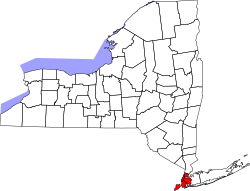
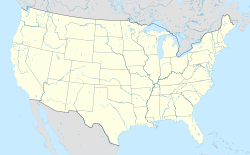


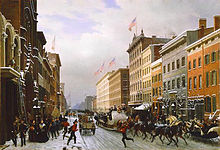

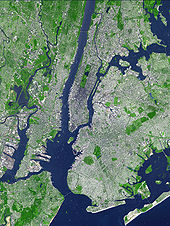

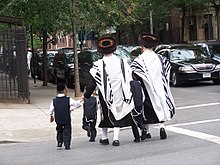


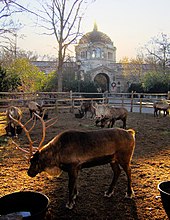


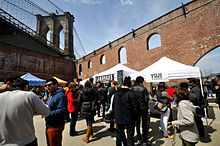

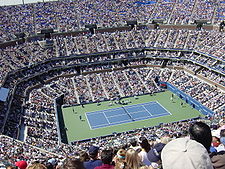
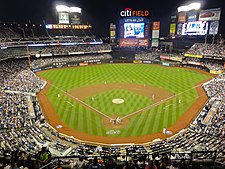


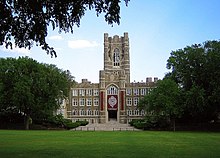
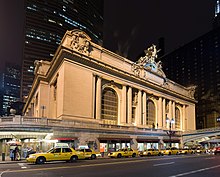
ليست هناك تعليقات:
إرسال تعليق